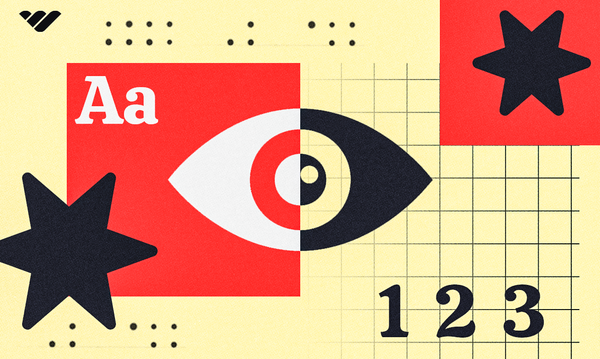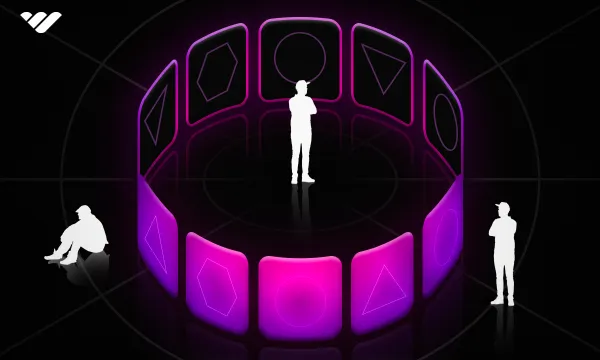Personal branding might sound like a marketing buzzword but it’s essential to success as an influencer or a solopreneur.
The first things that pop into your head when you think of big brands like Apple, McDonalds, or Louis Vuitton are likely all determined by each company’s personal branding.
In other words, the first things you think of are exactly what the companies want you to think of. This is the power of personal branding, and when used correctly, it can work wonders for you too.
In this article, I'll walk you through 20 examples of perfect personal branding, pointing out what they do right and the results they get.
I'll also guide you toward establishing your own branding!
What is personal branding?
Personal branding is how you present yourself to the world and show what you’re all about. It’s more than just your image; it’s a unique mix of your personality, values, skills, and passions—and how you show them off.
Think of it as the vibe you create, whether on your website, your own whop, or in your social media content.
When done right, your personal brand becomes something people recognize and trust, helping you create deeper connections and a lasting impression.
Personal branding isn’t about creating a "persona" but highlighting the real you in a way that resonates with your audience.
Why is personal branding important?
Personal branding can help pretty much anyone who markets themselves or their business, online or otherwise.
Whether you’re an influencer, freelancer, CEO, or solopreneur, a strong personal brand sets you apart and increases your impact.
You stand out from the crowd
In a sea of content and creators, personal branding makes you memorable. When people know what you stand for and see the unique personality you bring, they’re more likely to connect with you.
Your brand highlights what makes you different, helping you capture attention in a crowded space. And that’s especially important online, where everyone’s competing for the same screen time.
By showing your authentic self, you attract the right audience, and that means people who are truly interested in what you have to offer.
You look more professional
A polished, consistent brand builds credibility and trust. From your social media profiles to your website and email, a well-defined brand shows that you take yourself and your work seriously.
People are more likely to see you as an expert or authority in your field when they see a unified, intentional presence.
Even if you’re just starting out, a professional brand gives you a head start by conveying confidence and reliability.
Your message to the world is more consistent
Consistency in your message, tone, and visuals helps your audience know what to expect from you, building a sense of familiarity and loyalty.
They’re also more likely to recommend you to friends or share your content with others when they not only enjoy what you post now but also feel confident that it'll still be up their alley a week or a month from now.
Personal branding gives you new opportunities
Your personal brand can be a powerful magnet for new opportunities, from collaborations and partnerships to job offers and speaking engagements.
As you build your brand, you expand your reach and reputation, opening doors that may not have been available to you otherwise. When you’re seen as an expert in your field, people naturally seek you out, and you may even find yourself invited to work on exciting projects or join inspiring communities.
Personal branding isn’t just about looking good; it’s about positioning yourself in a way that attracts opportunities that align with your goals.
20 examples of personal branding done right
Personal branding is probably the single most important thing when it comes to running a successful online business.
You're not a local business that everyone in town knows and trusts, but with the right personal branding, you can feel like one—even if you have millions of followers.
Here are some of my favorite examples of personal branding done right. These creators aren't just successful; they're super inspiring and I've learned a lot just from getting to know them a little bit more.
1. Natasha Ibrahim
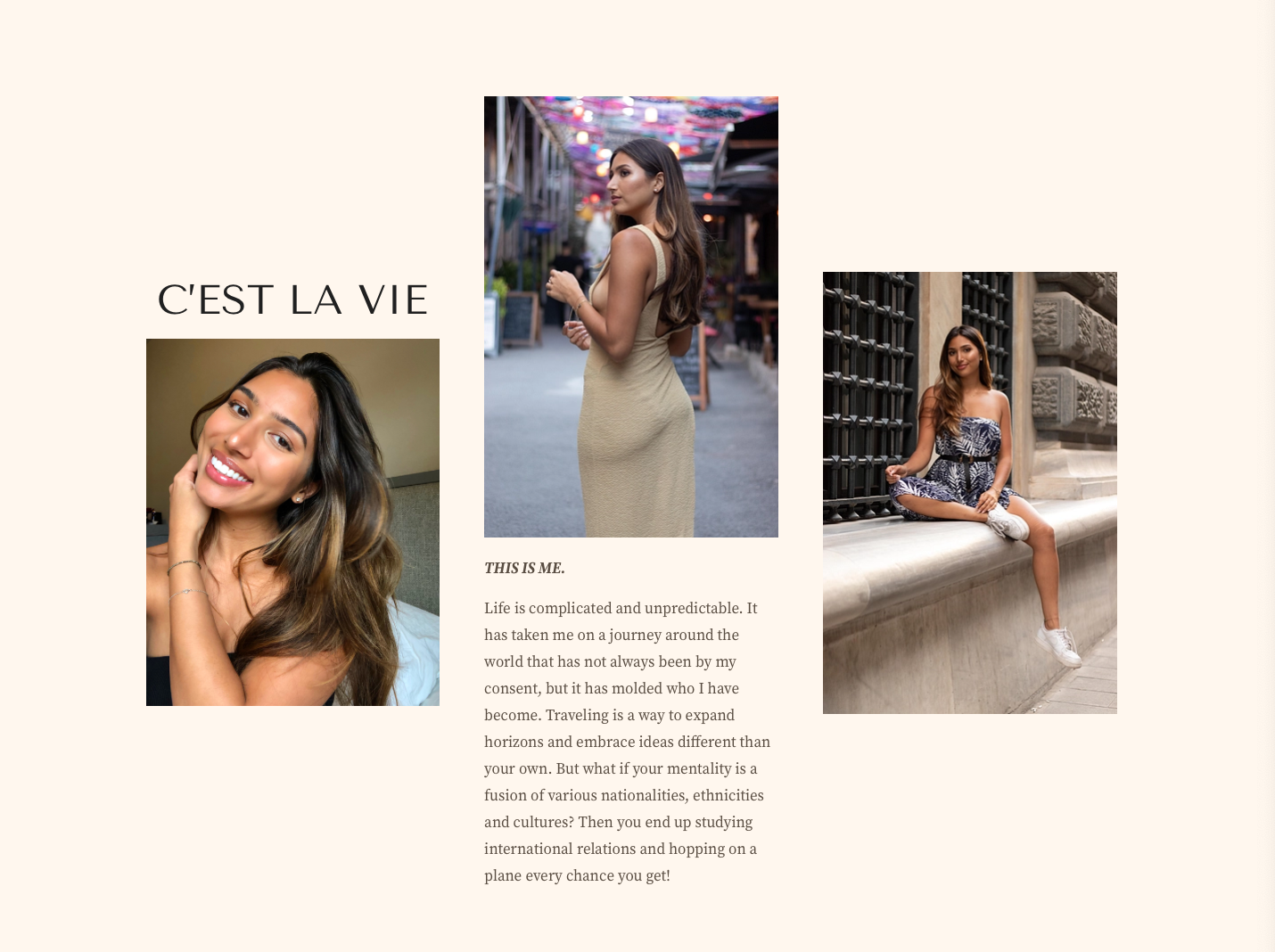
Natasha Ibrahim is an entrepreneur and influencer who showcases her life as a digital nomad and coaches people to help them achieve a similar lifestyle.
You can find her across many different platforms, from Instagram to YouTube, but most of all, she even has her own exclusive community on Whop called Girl Boss Abroad, which is one of the best digital nomad communities for women in the world.
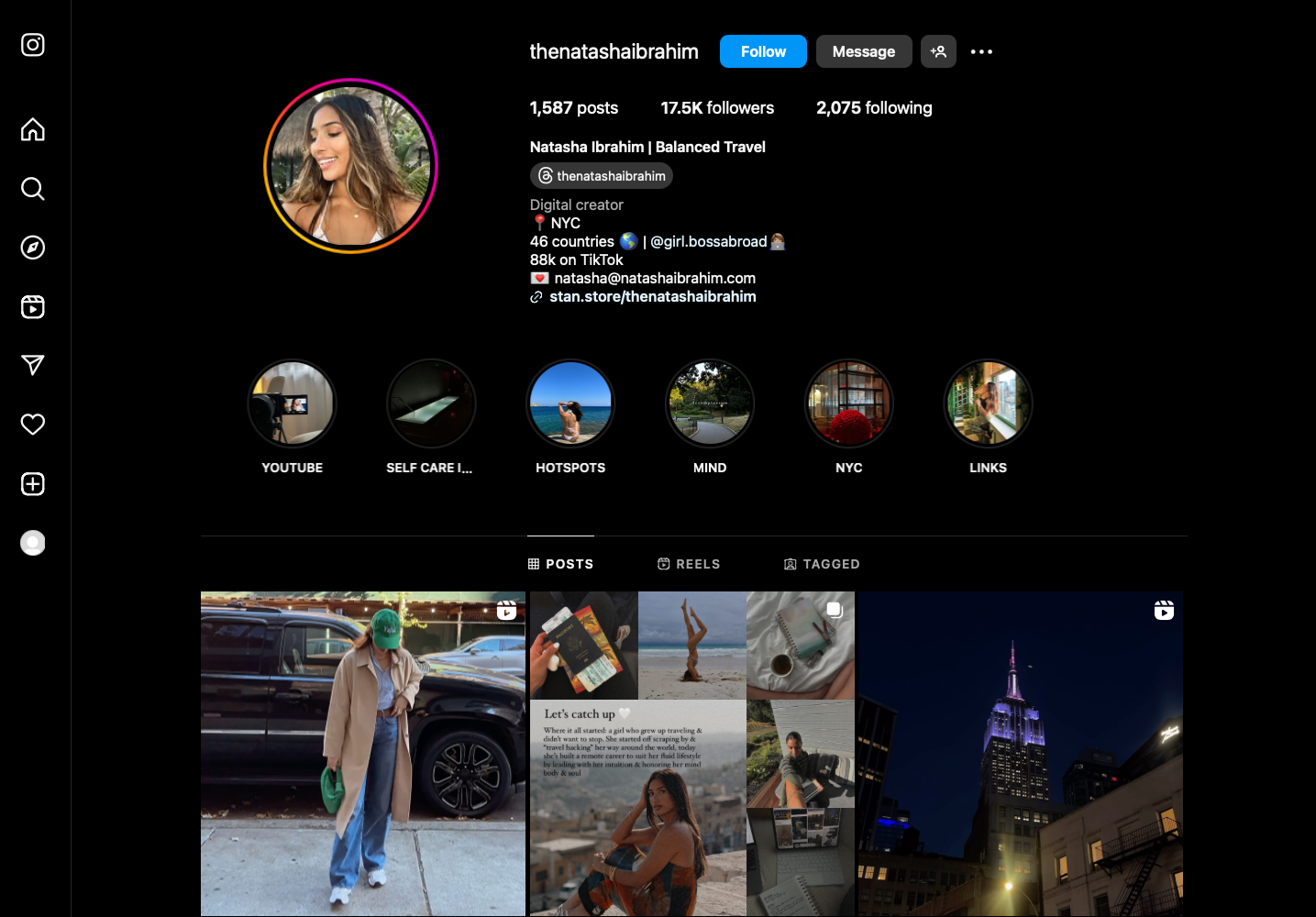
Natasha’s life is all about travel and discovery—while not only earning enough to pay for it but also making a profit. At just 22 years old, she's lived in multiple cities across the world and developed a personal brand for herself that focuses on her unique experience.
What makes Natasha’s brand stand out
Natasha’s niche is based on who she is, her upbringing, and the life she lives now. In other words, it’s a gap that literally only she can fill.
No one has led the same life as her, and no one has the exact same expertise and views of the places she has been.
By filling her content with not only the personal experience and expertise she’s gained from living the digital nomad life but also the style of a social influencer, she’s able to both grab people’s attention and deliver value.
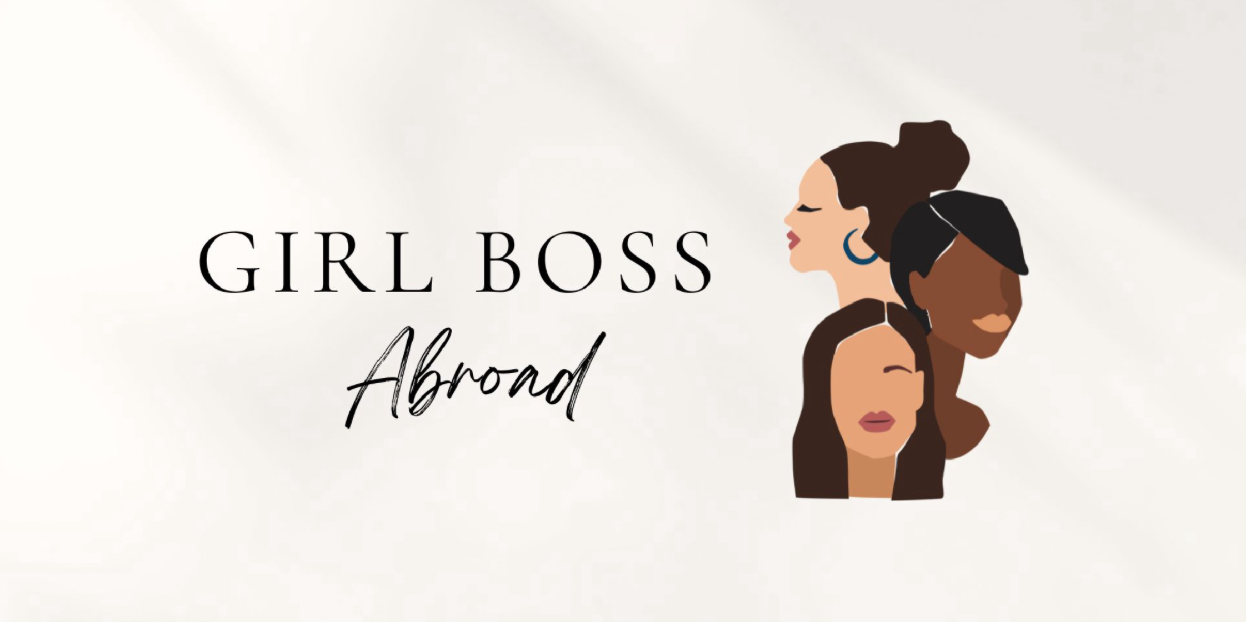
Examples of personal branding used by Natasha
A big part of Natasha’s branding is herself and her travel, so you won’t find generic images on her socials that could have just been taken by anyone. Every photo has Natasha in it, reminding everyone that she has really been to and really experienced the things she talks about.
The other biggest element of her branding is language: it’s positive, chatty, and genuine. It shows off what she has now but always focuses on what she started with and how she got there.
This is especially impactful because helping others achieve the same lifestyle is part of her product.
2. Alex Sedlak
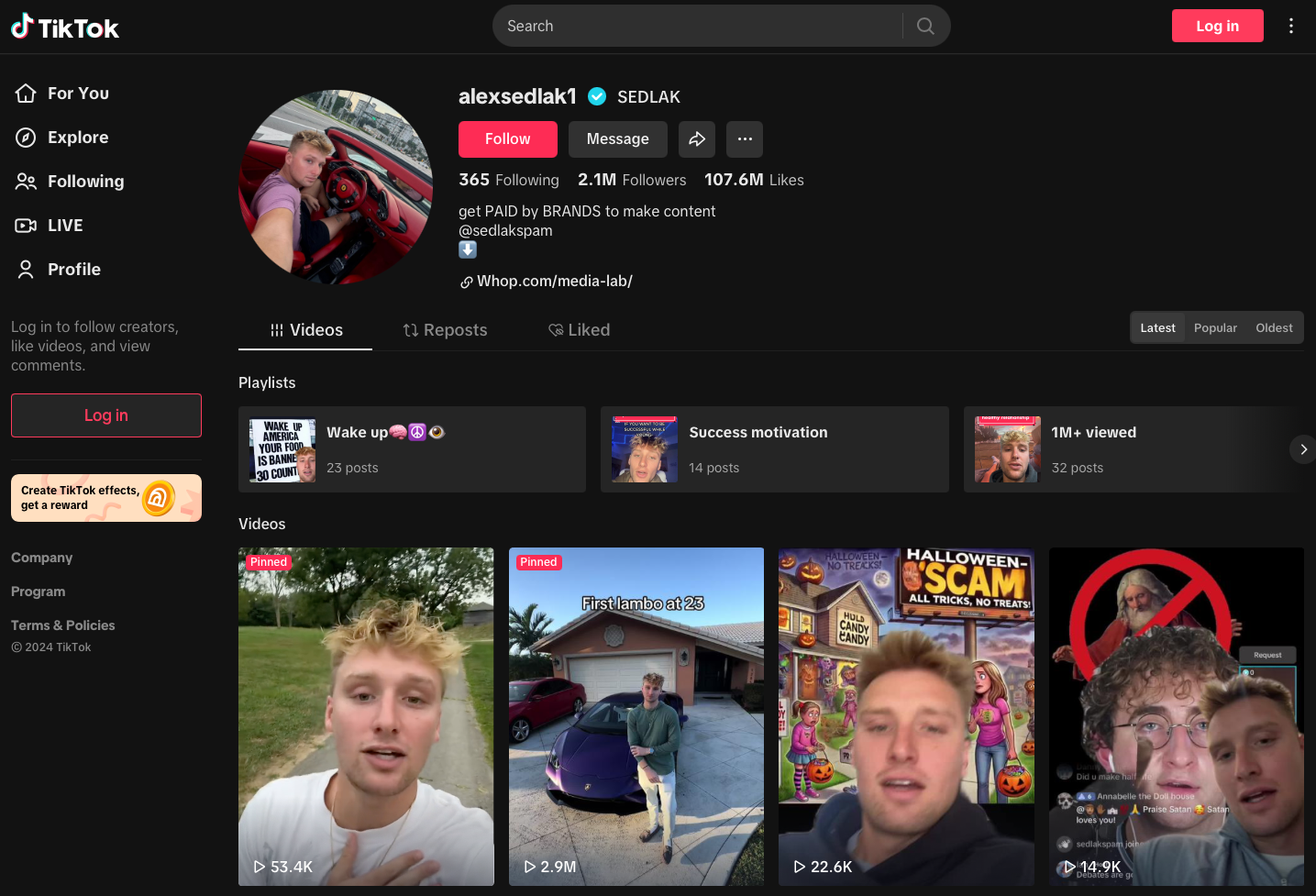
Alex Sedlak is 24 years old and has built a content business that can make a professional’s yearly salary in just one day. Essentially, he gets paid by brands to create content on TikTok Shop. This is otherwise known as affiliate marketing.
And, as he has gotten better and better at it, he has also started making money by teaching others how to become affiliate marketing pros through his two Whop communities: Media Labs and Print Money W TikTok.
Aside from his whops, you can also find Alex on YouTube, Instagram, and TikTok, where he has over two million followers.
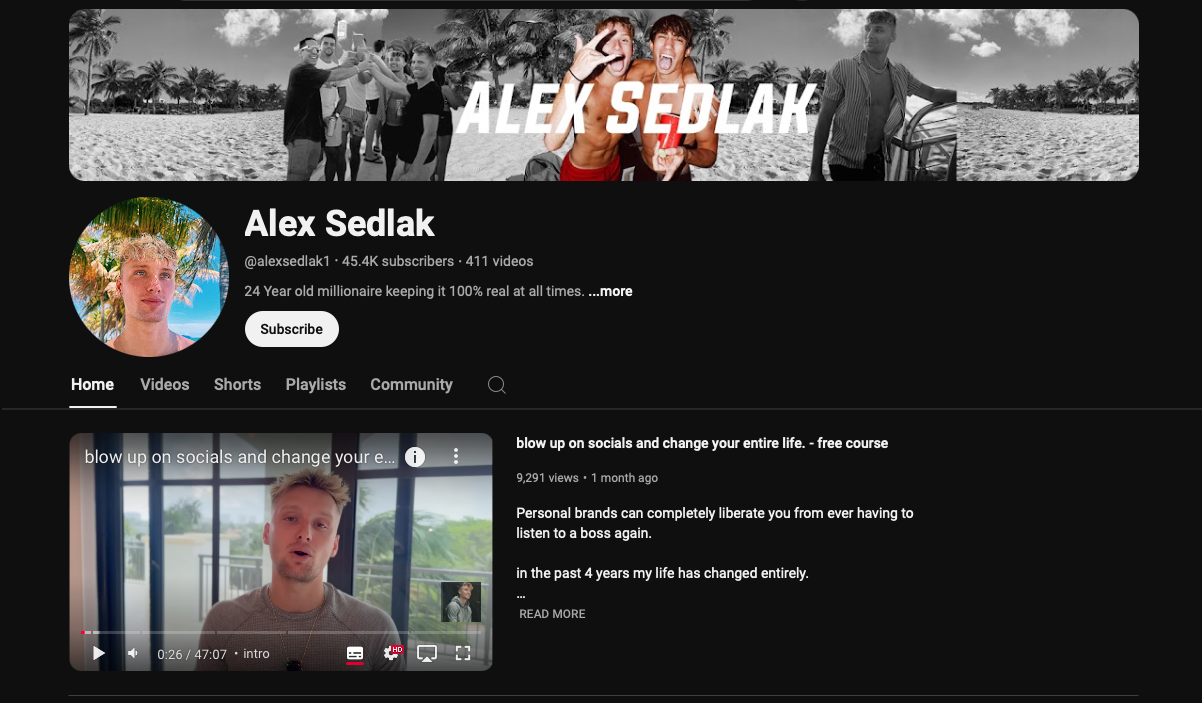
What makes Alex’s brand stand out
Alex’s personal brand is all about results. His two million followers, his profit margins, the success of his online courses—all of these are proof that he knows what he’s talking about!
Alex turns that into branding by posting lots of honest content about how he’s achieved it and what it’s like to succeed.
The key to lasting success on social media is having a hook that can pull in all sorts of people, and then delivering real value that makes them stick around.
So, while people initially click on Alex for the posts of his expensive cars and enviable lifestyle, they stay because he delivers genuinely good advice for people who want to achieve the same things as him.
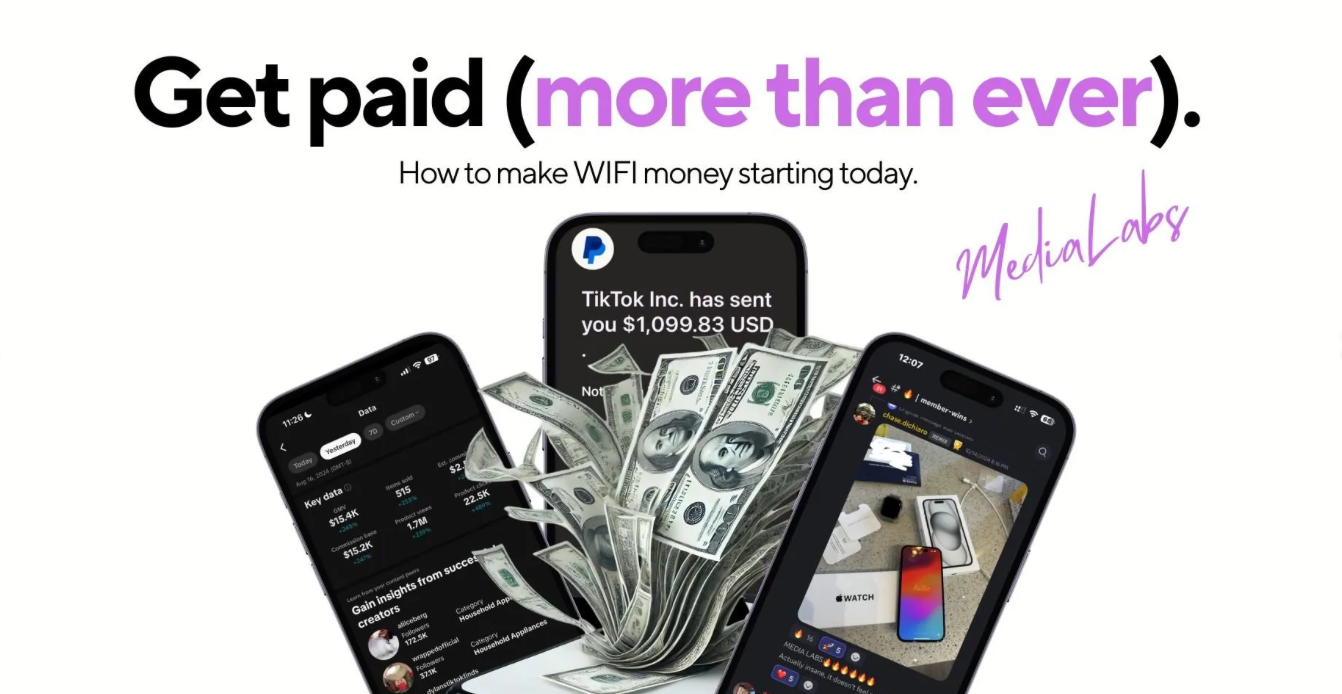
Examples of personal branding used by Alex
Language is extremely important in Alex’s personal branding. His content is a balancing act between showing you what he has achieved and reminding you that he started in the exact same position you’re in now.
To achieve that balance, Alex talks to his audience on a personal level, weaving in enough technical terms to provide helpful advice to people of all experience levels, but not enough to scare away beginners.
People who buy Alex’s courses work directly with him, so part of his brand is being approachable, easy-going, honest, and trustworthy. At the same, he also gets people hyped by using phrases like "blow up," and "change your life."
3. Emma Chamberlain
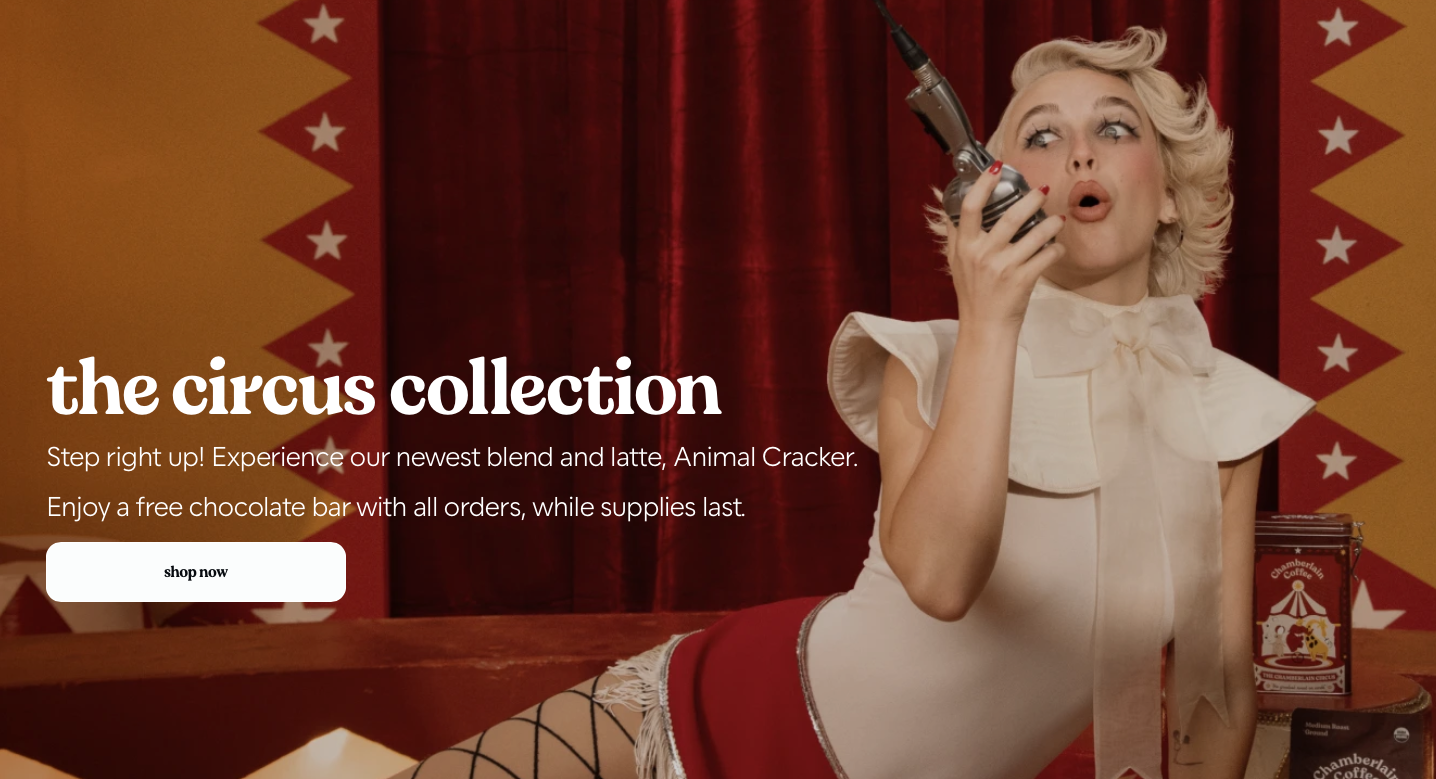
Emma Chamberlain is a 23-year-old influencer and businesswoman. After starting off on platforms like Instagram and YouTube, she now runs a coffee company and works with companies like Louis Vuitton, Lancome, and Cartier.
She’s attended the Met Gala and various fashion weeks as well as appearing in magazines like Vogue and Cosmopolitan.
She currently has 15 million followers on Instagram and 12 million subscribers on YouTube.
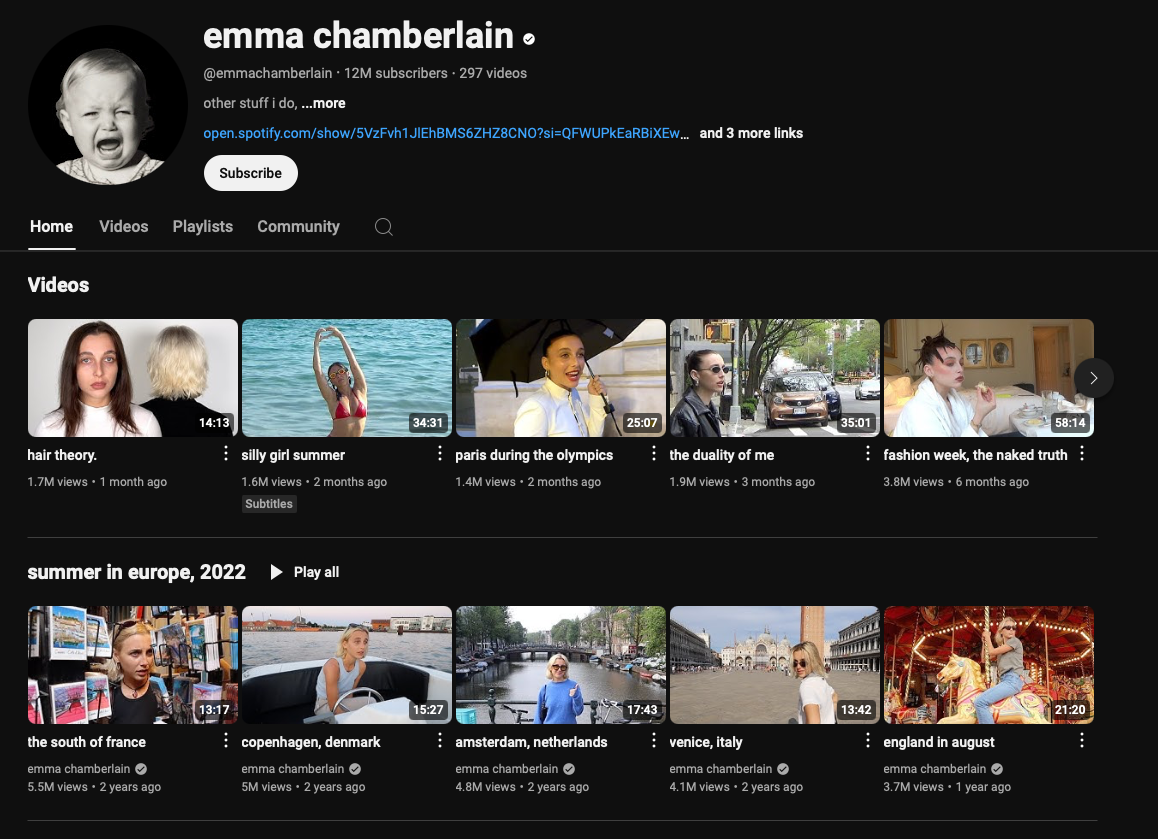
What makes Emma’s brand stand out
Emma is known for her snappy video editing and dry humor, which she now brings to other business ventures as well.
As she was growing her following on YouTube, her love for good coffee made its way into a lot of her content—which is why the coffee business she runs now fits her brand so well.
This is an example of how personal branding isn’t just about how you do something, it’s also about what you actually do. You can match fonts, logos, and language as much as you want but if what you do doesn’t fit your brand, it will never click together as well as it could.
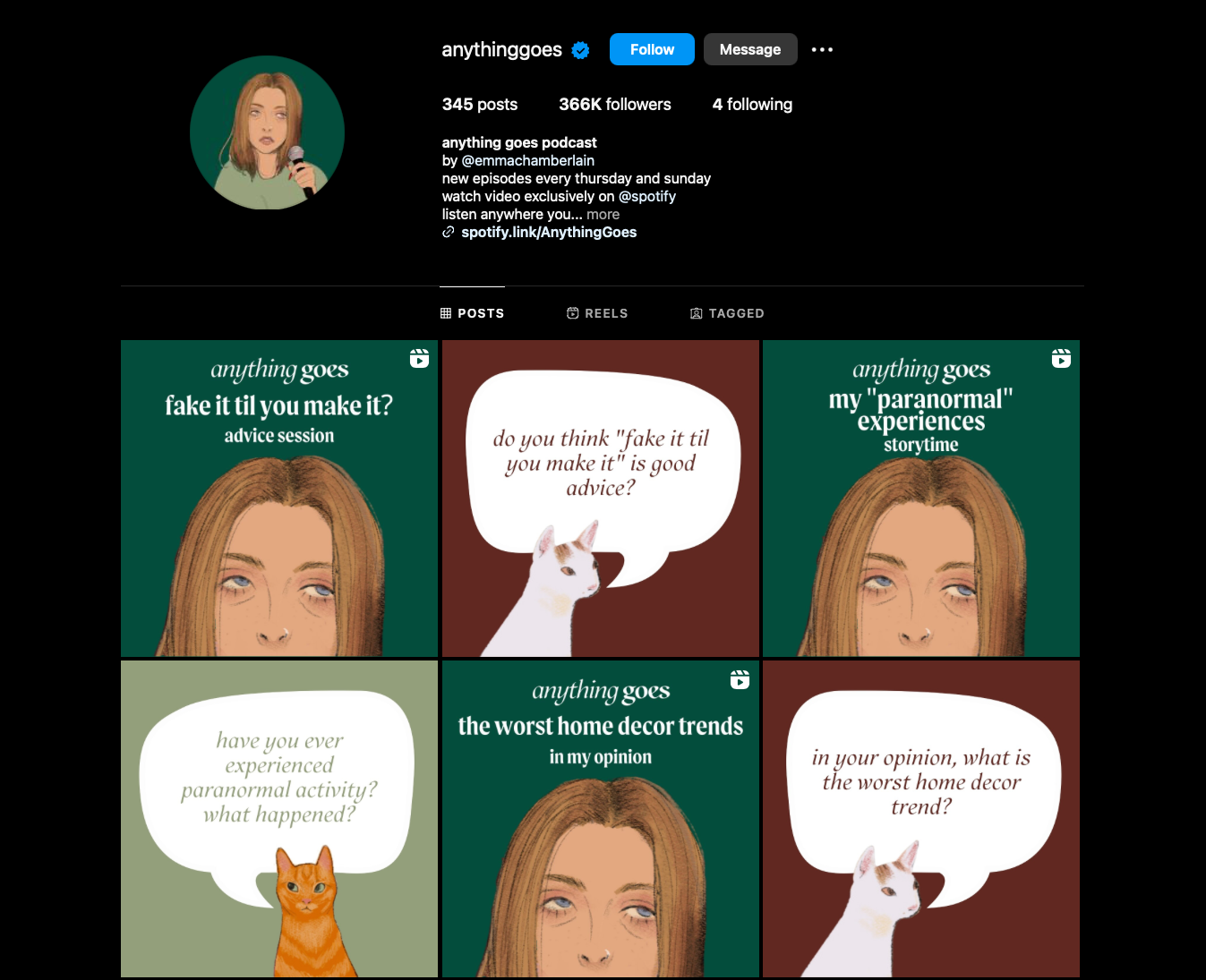
Examples of personal branding used by Emma
Emma has naturally "tired" looking eyes that happen to work as a perfect motif for her dry, self-deprecating humor. She focuses on them a lot in the photography she posts and in the art for her podcast that you can see in the image above.
It’s a great bit of personal branding because Emma’s eyes are, of course, unique to her, while also embodying her style of content and humor. They’re also super striking and recognizable, which plays into the modeling and ambassador work she does as well.
Of course, not all of us have a feature that stands out in this same manner, but it's not about the looks. It's more about finding something unique to you and building on it, making yourself recognizable.
4. Jasmine Green
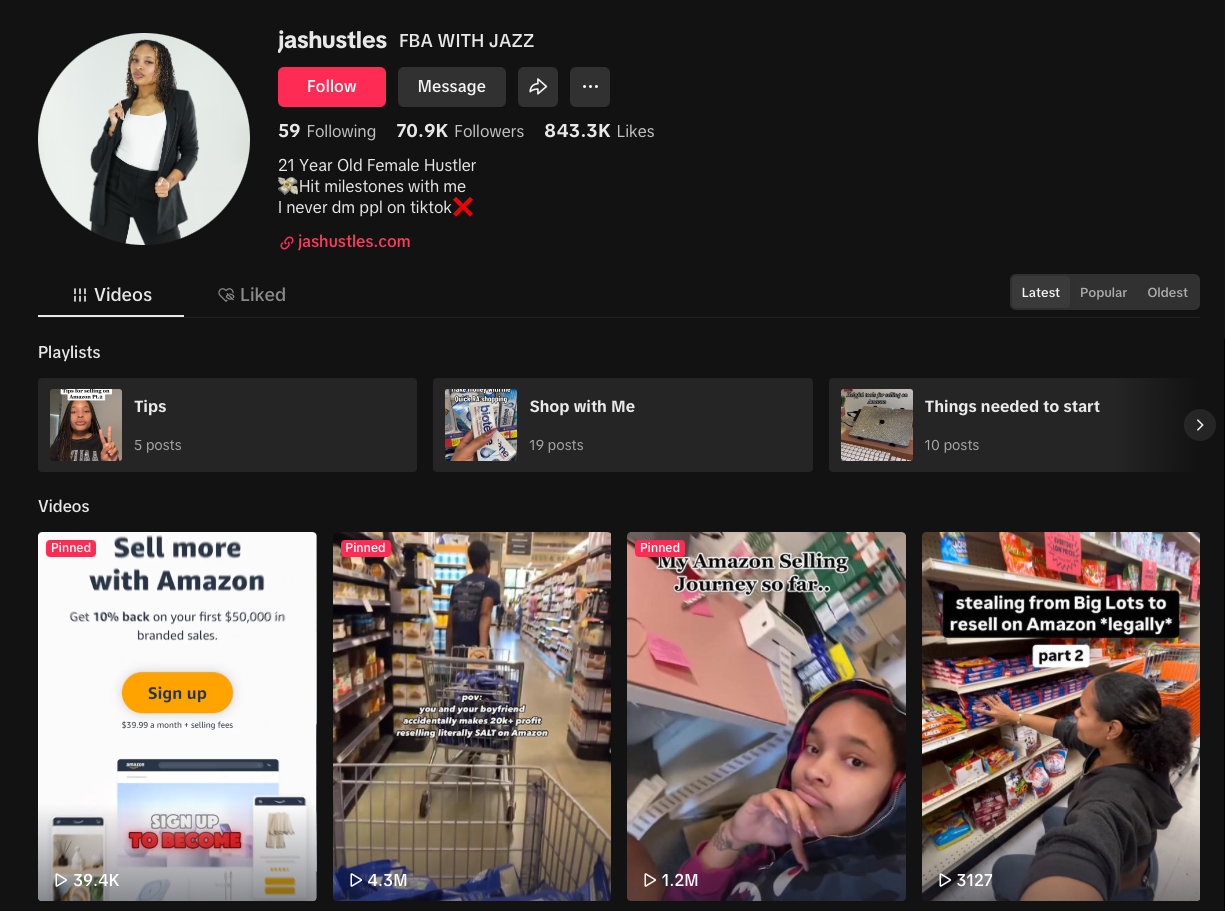
Jasmine Green, otherwise known as Jashustles, is a 21-year-old entrepreneur who makes her money by reselling stock on Amazon. This involves buying physical goods on sale in stores, looking after the stock herself, and then reselling it on Amazon.
The trick is, of course, to buy items that are on sale in the store for less than the RRP or average selling price on Amazon. She posts her tips and finds on TikTok, having created a following of 125,000 people and earning six figures in the process.
Now, she shares her tips, strategies, and networking contacts officially through her Exclusive Hustlers Whop community as well as her Hustlers Academy course.
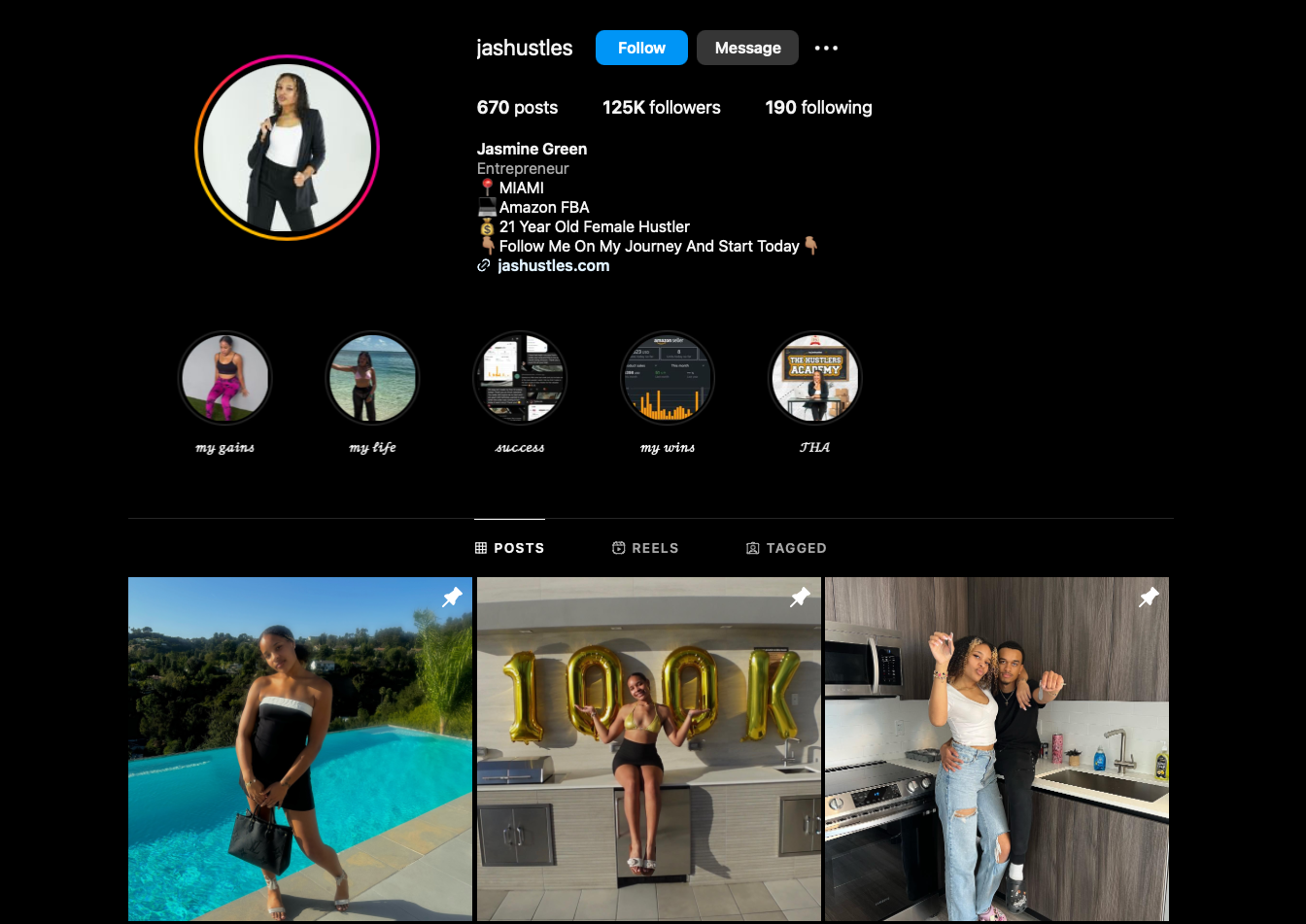
What makes Jasmine’s brand stand out
Jasmine started her Amazon reselling business when she was just 19, and her branding is very influenced by her young age and her local culture.
She hasn’t pivoted into a "LA penthouse" style influencer now that she's successful, instead aiming her content at young people with lives similar to her own before she started her business.
This gives her branding a genuine and down-to-earth feel, which speaks to her intended audience.
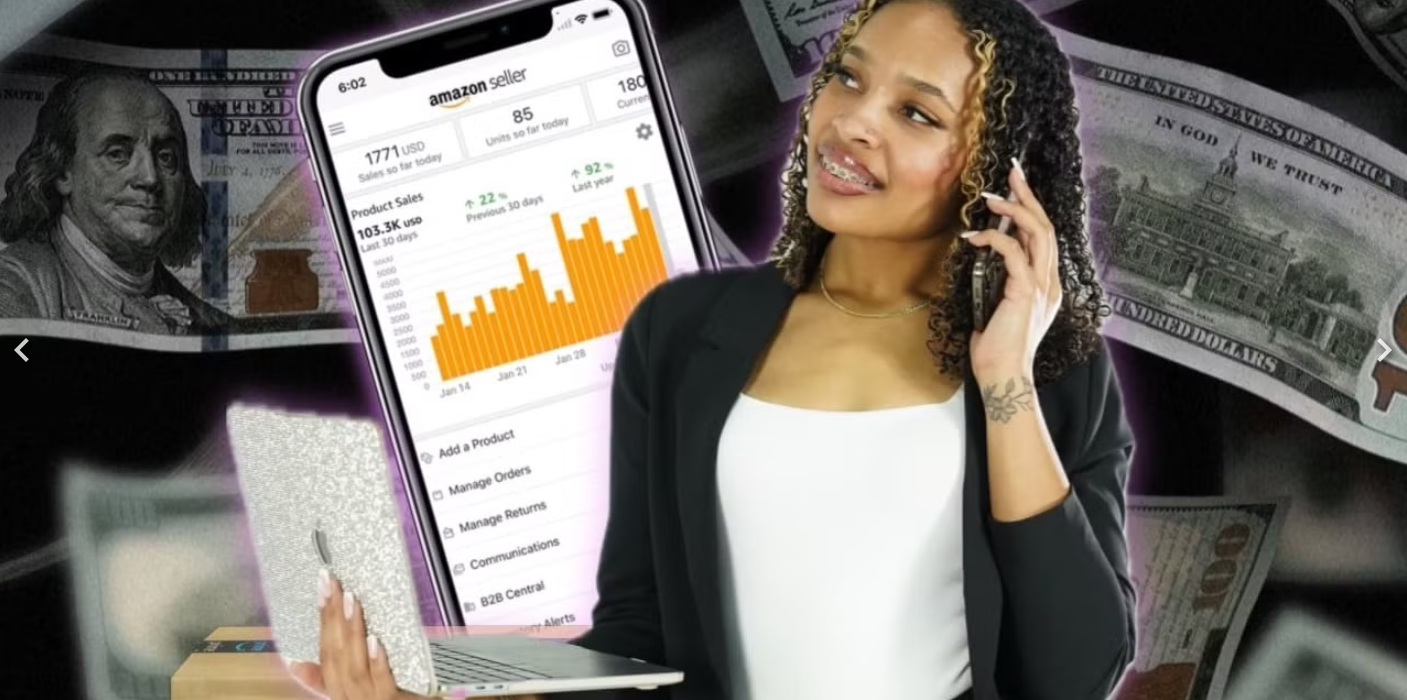
Examples of personal branding used by Jasmine
Jasmine started on TikTok and has based a lot of her branding around the style of American TikTok culture. This means cash motifs, sparkles, music and editing, and lots of viral TikTok template-style language.
It’s admittedly something that a person well into their 50s might see and not understand much at all—but that’s okay because it’s more than relatable to her target audience.
Her use of the word "hustler" is also a big part of her branding and it talks to a very specific niche and culture of people who have taken the word and begun to reshape its original meaning.
5. Musa Mustafa
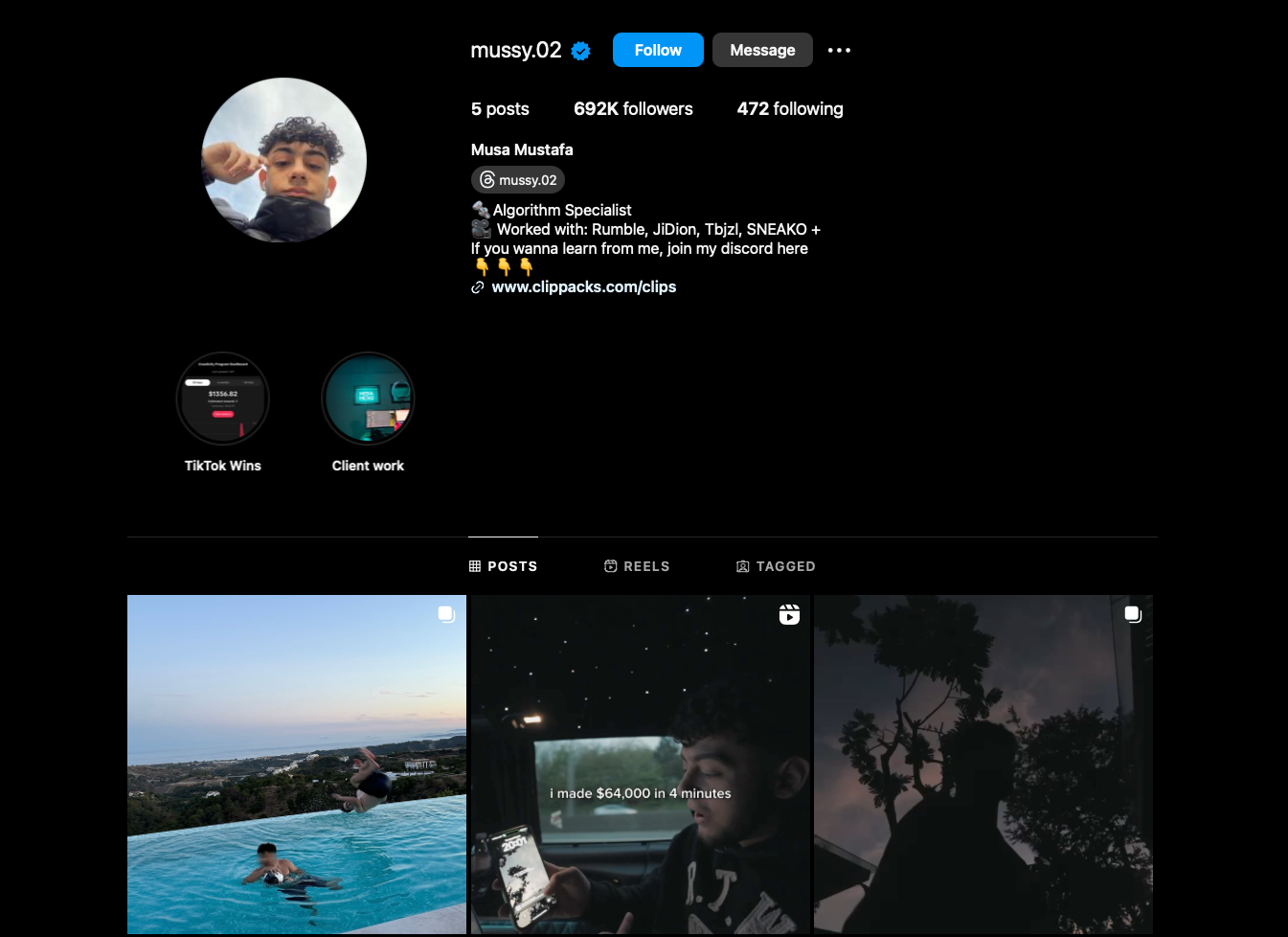
Musa Mustafa started his career when he was a teenager by editing videos and managing content for influencers like Sneako. From this experience, he learned how platforms like Instagram, TikTok, Twitch, and YouTube really work and is now making money passing on his knowledge to aspiring influencers.
His Whop community Media Metas teaches people how social media algorithms work and what they need to do to go viral quickly.
What makes Musa’s brand stand out
Part of the draw of Musa’s brand is that he proves success isn’t just for influencers.
That's right: Your face doesn’t need to be on everything and you don’t need to be on camera every day. You can also work behind the scenes.
He presents as a very normal kid who grew up on TikTok and other social media—one of the many who try to break into this industry but one of the few who succeed.
Who better to learn from, right?

Examples of personal branding used by Musa
Musa doesn’t put on any airs when he posts content about his business. He tells it like it is, uses the style of language he grew up with, and presents himself with confidence.
You can see this laidback language in the video content he posts and in his product descriptions for the courses he sells. If you join his exclusive Discord community, you’ll be sure to see the same patterns there.
This use of language brings Musa closer to his audience and lets them communicate on the same level. Teens and young adults who want to learn how to start their own side hustle on Instagram want to be spoken to naturally and by people they feel a connection to.
6. Gary Vaynerchuck
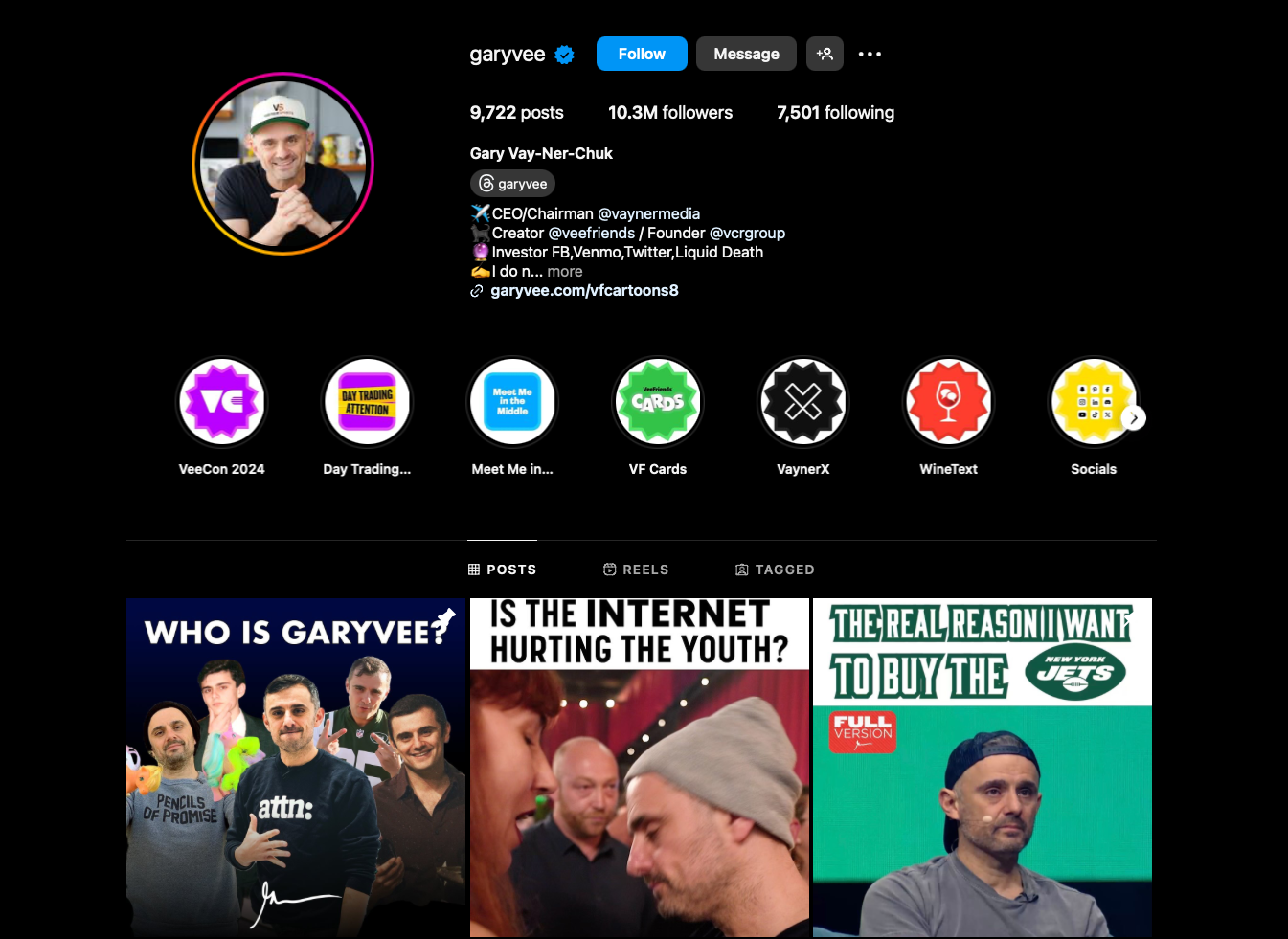
Gary Vaynerchuck, otherwise known as GaryVee, is an entrepreneur and social media creator with multiple business ventures. He focuses on positivity and motivation, attempting to inspire the 10 million people who follow him on Instagram, and the 15 million who follow him on TikTok.
On TikTok, some of his posts have over 50 million views and he’s also the Chairman of Vaynerx, CEO of Vaynermedia, CEO of VeeFriends, and an NYT bestselling author.
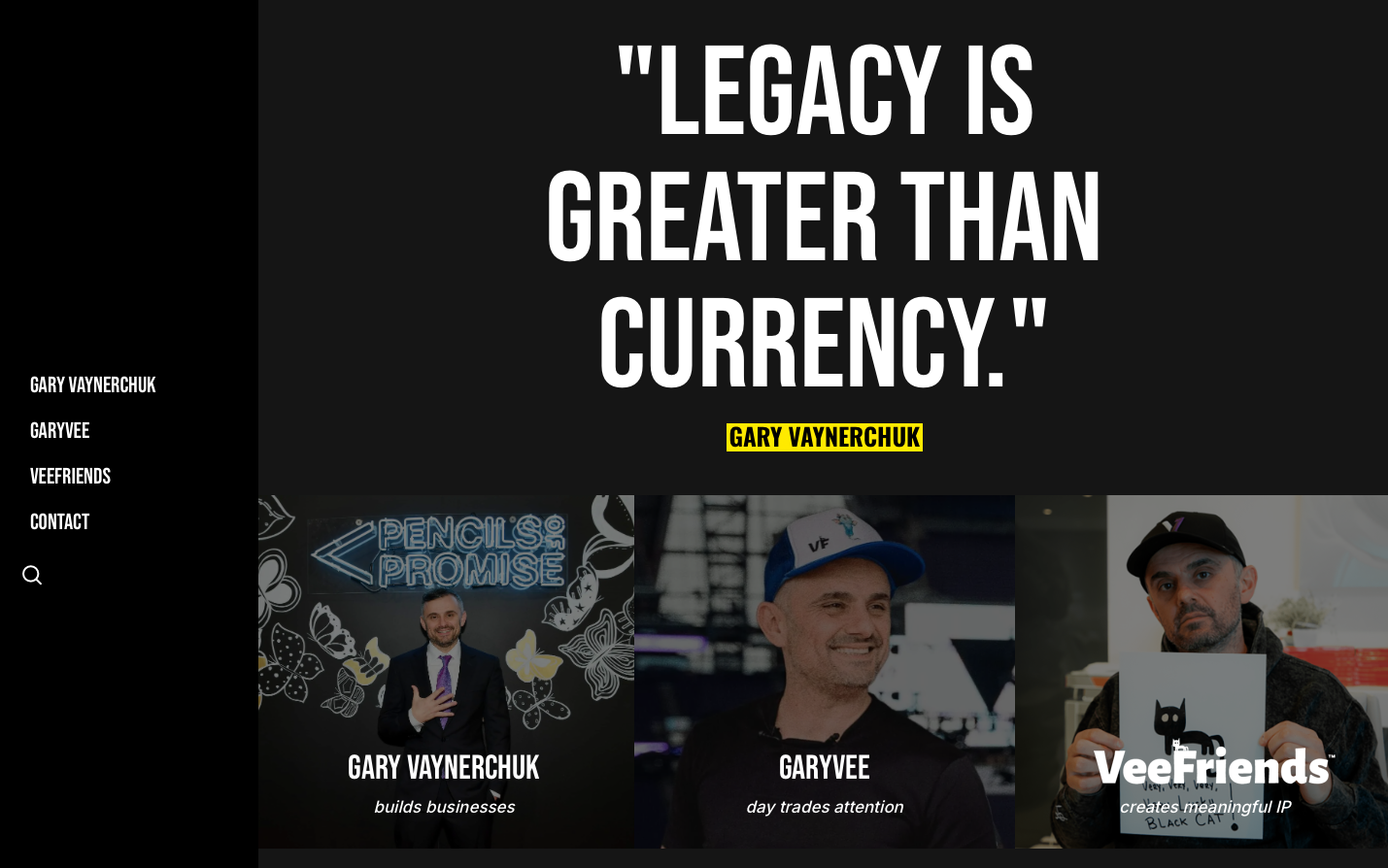
What makes Gary’s brand stand out
First of all, you can find Gary anywhere and everywhere: he has books; he has companies; he’s on YouTube; he’s on TikTok; he’s on Instagram; he’s on X—literally everywhere.
This means that no matter what your preferences are, you have easy access to Gary and his work. Once you start reading his sites and socials, you’ll quickly notice the empowering, no-nonsense style he uses to present his motivational advice.
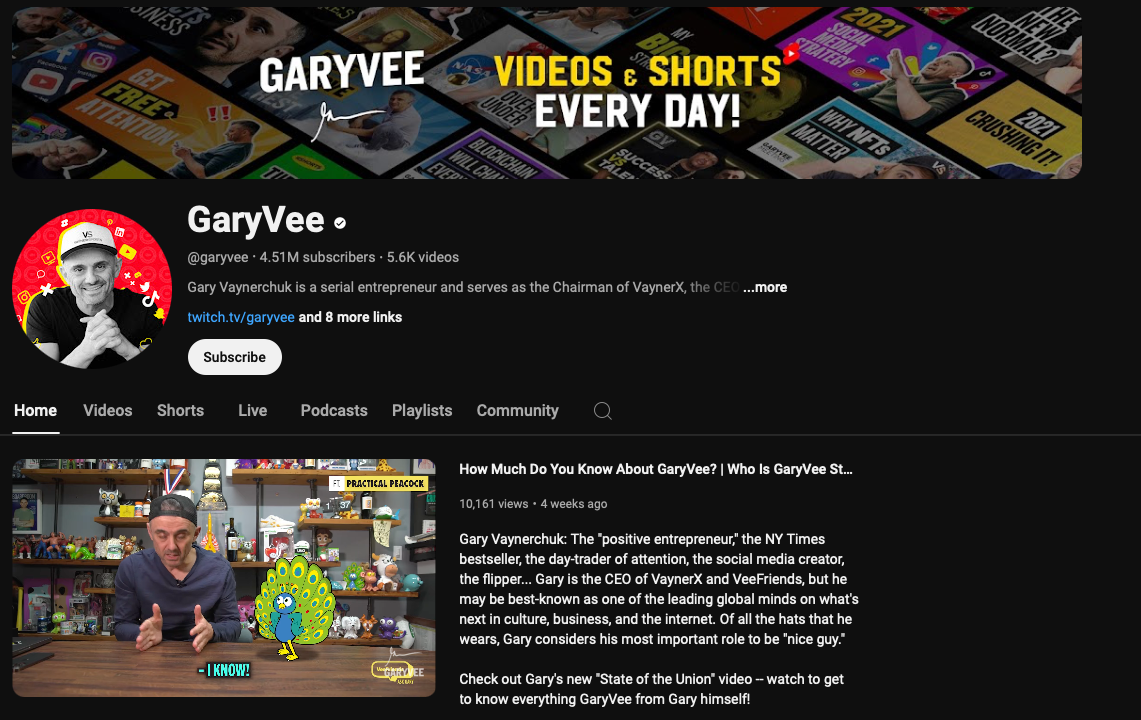
Examples of personal branding used by Gary
Gary uses a color theme across his various brands and socials: yellow and white. These colors are used mostly across logos and text, giving Gary’s ventures a unified look without going over the top.
Gary also makes engagement a key element of his branding—across his socials, he’s constantly posting questions and encouraging his followers to interact with him.
This helps to build his image of “being a nice guy,” which he claims is the most important title he owns!
7. Kaleigh Moore
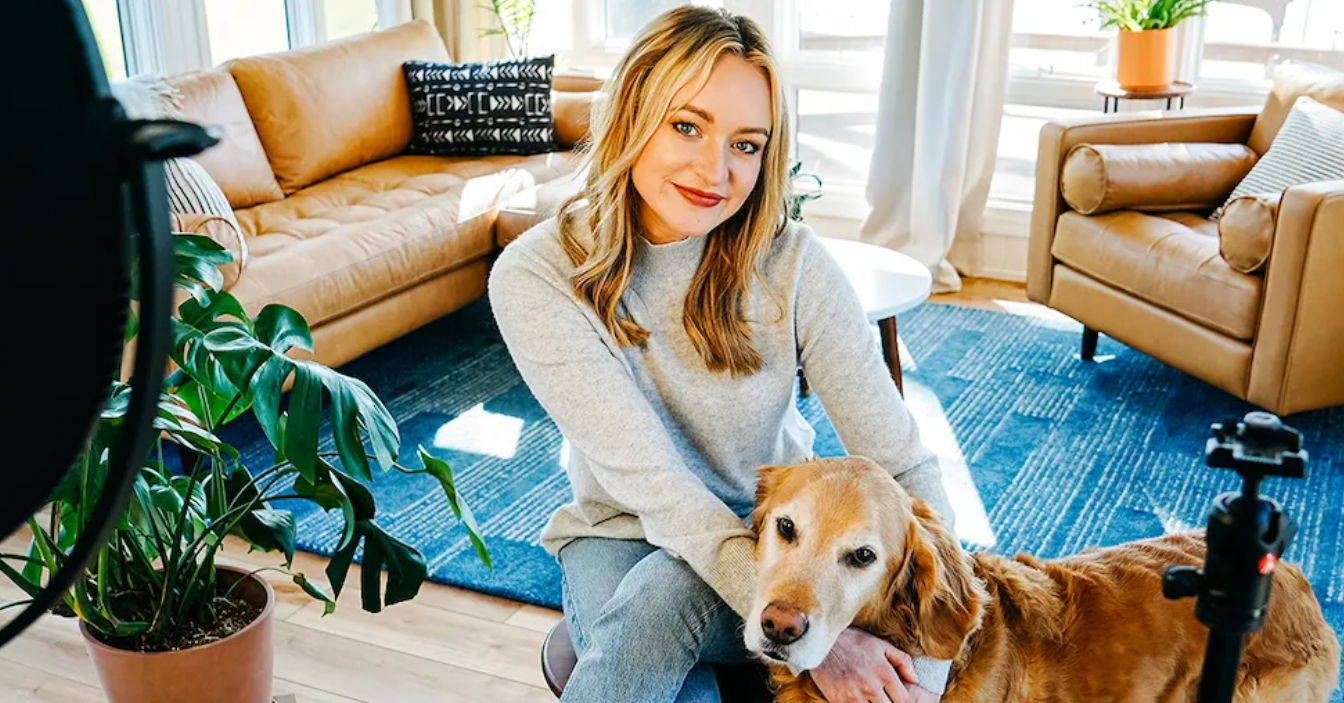
Kaleigh Moore is a seasoned writer and journalist who specializes in ecommerce and SaaS. Aside from writing for Whop, Kaleigh has also written for big-name publications like Vogue Business, Fast Company, and Entrepreneur.
As well as doing her own writing, she also teaches others how to break into the freelance writing industry and improve their skills. On Whop, she runs an exclusive community full of practical resources and one-on-one coaching for aspiring writers.
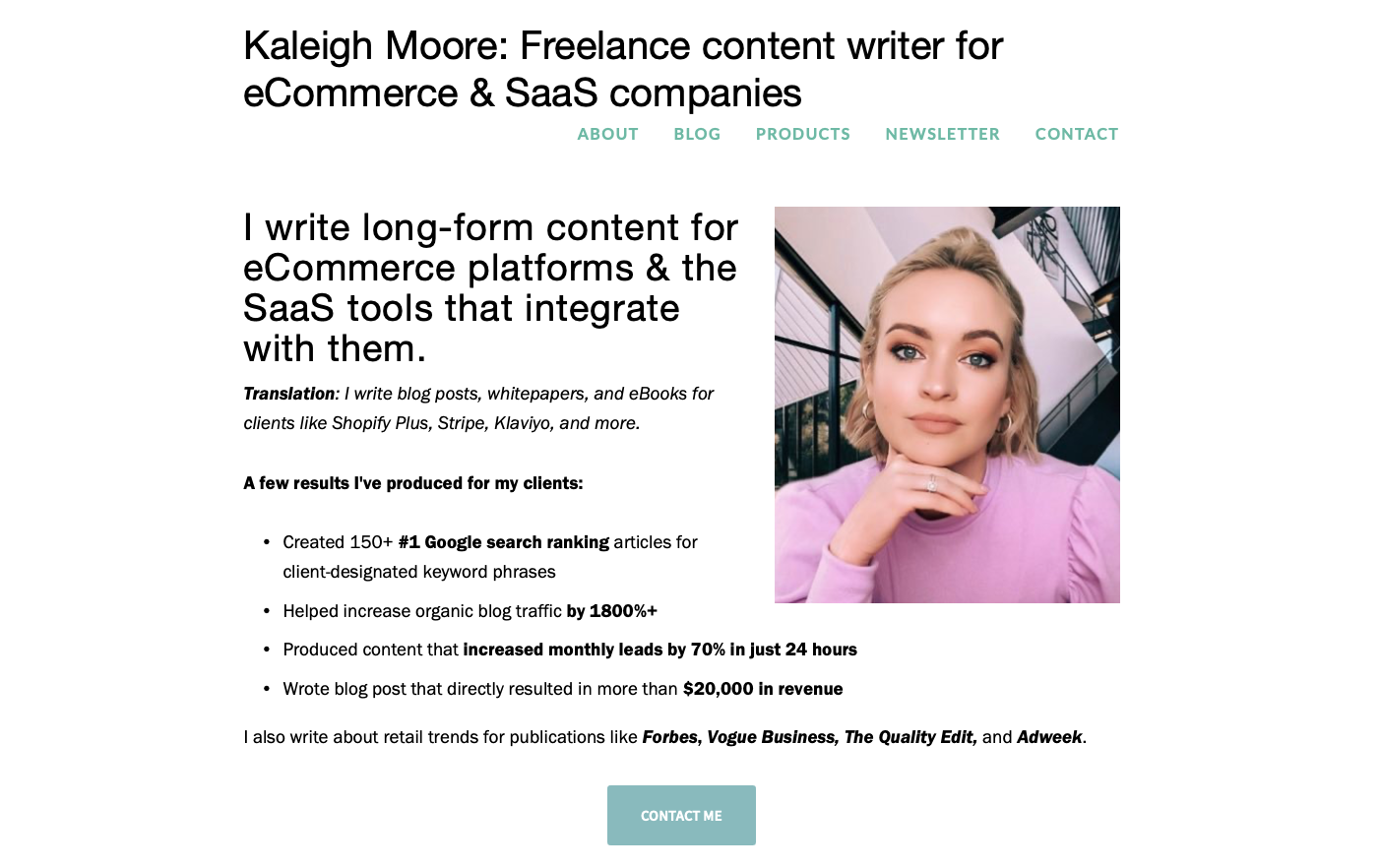
What makes Kaleigh’s brand stand out
Kaleigh is all about content authority. She centers her brand around her experience and expertise in her chosen niches.
This is backed up by her association with well-known brands and publications, allowing her to instantly build trust and credibility with visitors to her sites and socials.
With her experience doing most of the work for her, Kaleigh finishes the job by using authoritative but friendly language to welcome visitors and encourage them to work with her.
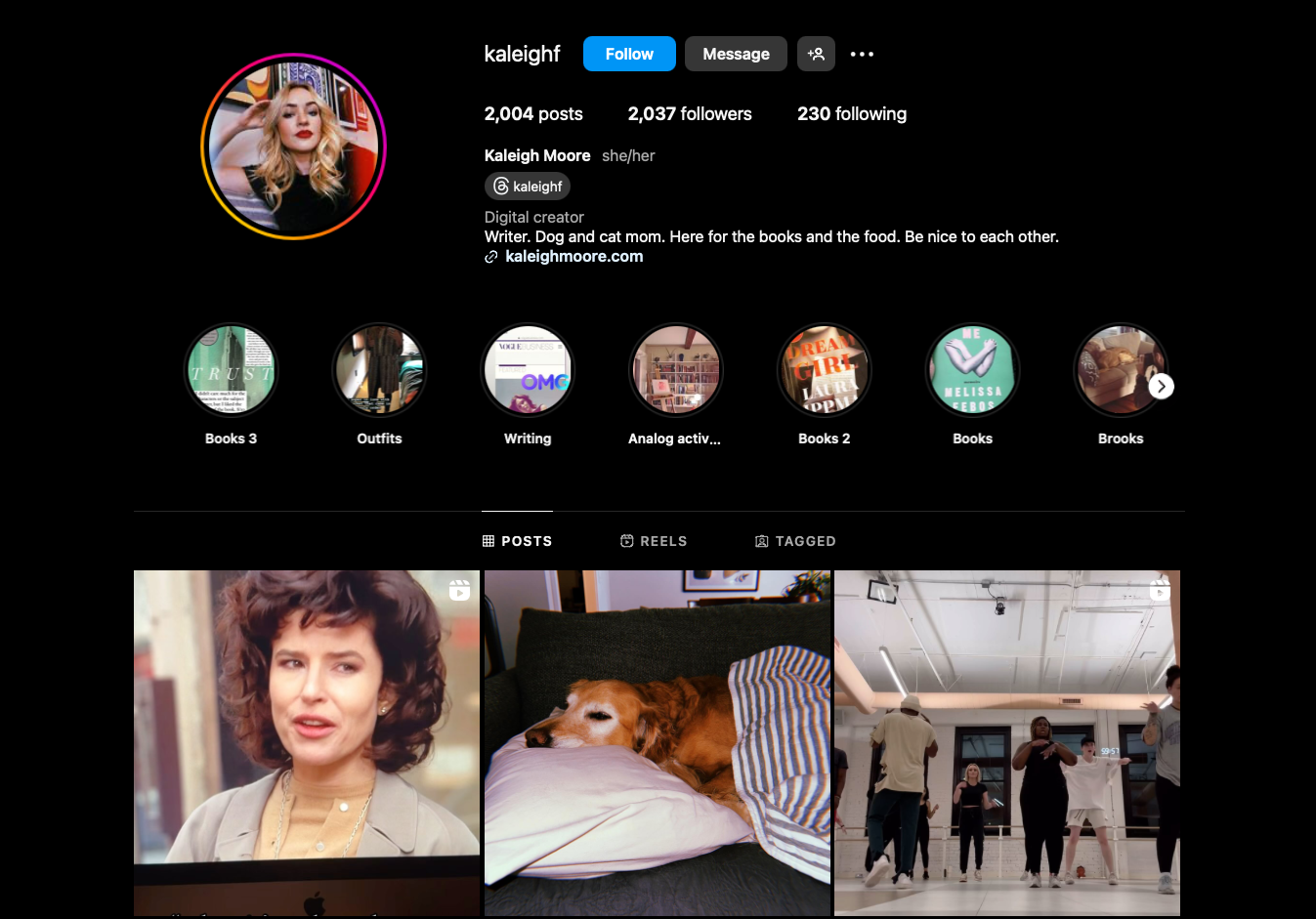
Examples of personal branding used by Kaleigh
Kaleigh is a writer, and she draws focus to her words by using clean, direct presentation on her website. There’s no fuss, limited images, limited colors, and simple formatting.
Across her socials, she reinforces her expertise by engaging in the industry news of her niches, showing that she lives the topics she writes about and will always be on top of industry trends.
8. David Hunter
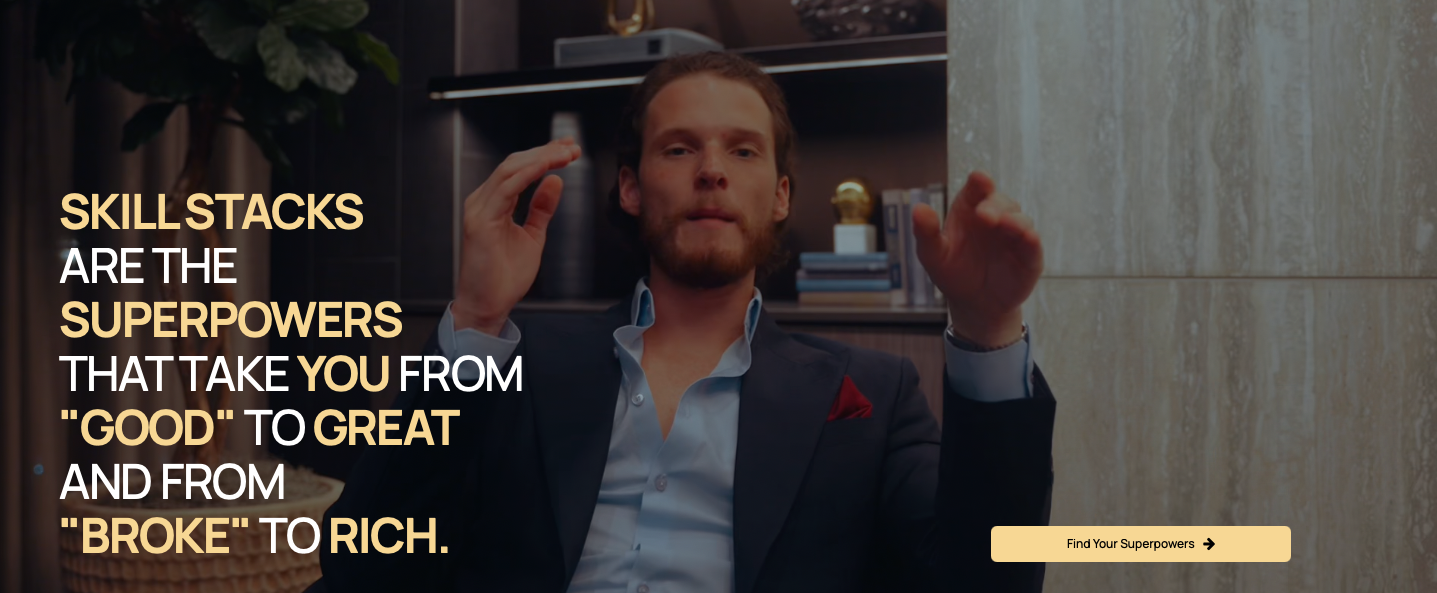
David is a consulting and software entrepreneur who runs the company Skill Stacks. He teaches people the business model and success techniques he used himself to quit his sales job and become an entrepreneur.
Skill Stacks is also hosted on Whop, where you can access products like David’s ebook, courses, and exclusive in-person events.
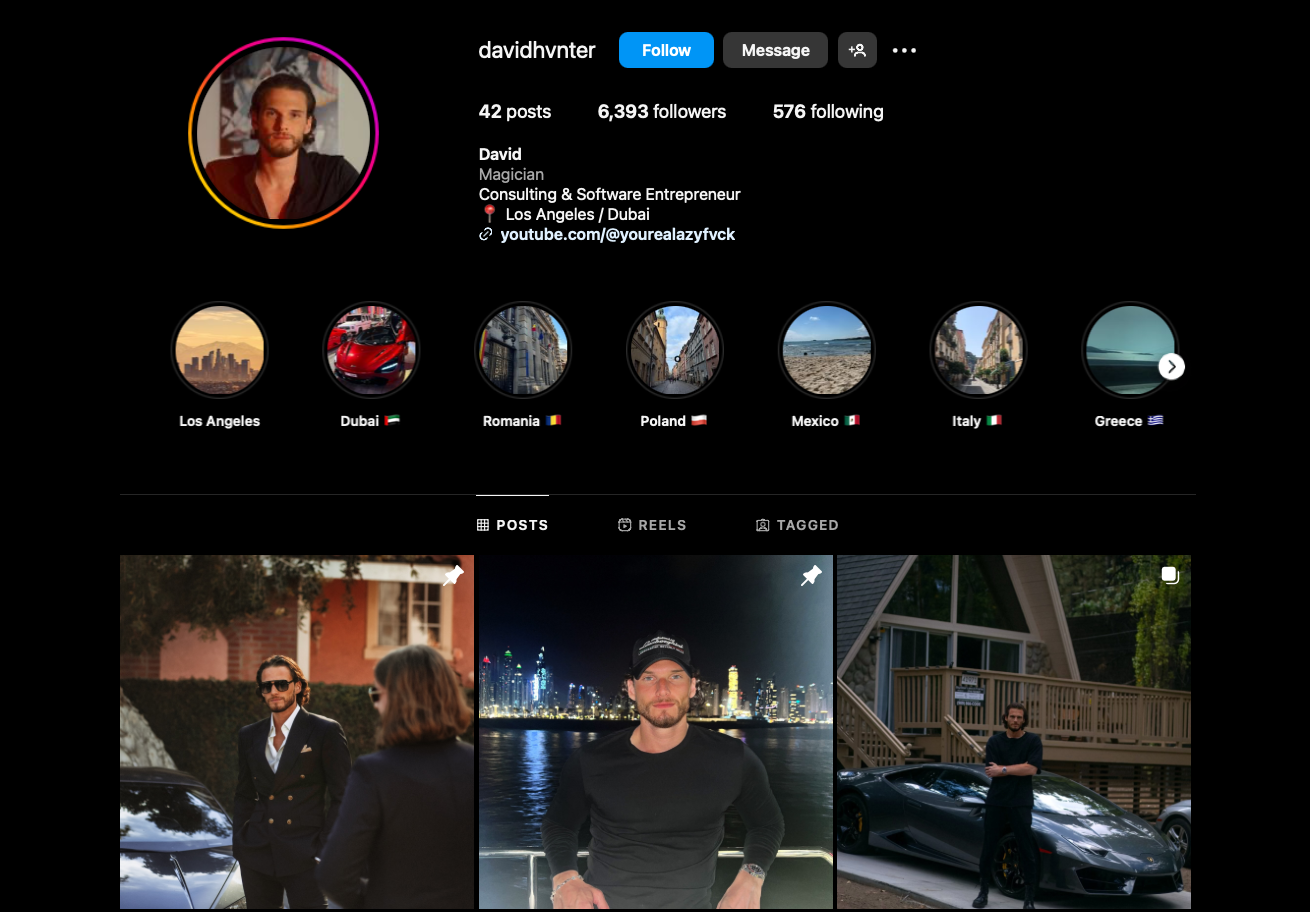
What makes David’s brand stand out
David goes for the bold, provocative style with his branding. He shows you what could be yours if you find the success he has.
He uses some edgy language to grab attention, calling himself an "ex-loanshark turned cult leader" on his X bio. His social handle is even part of the branding—@yourealazyfvck—baiting people to get angry and prove him wrong.
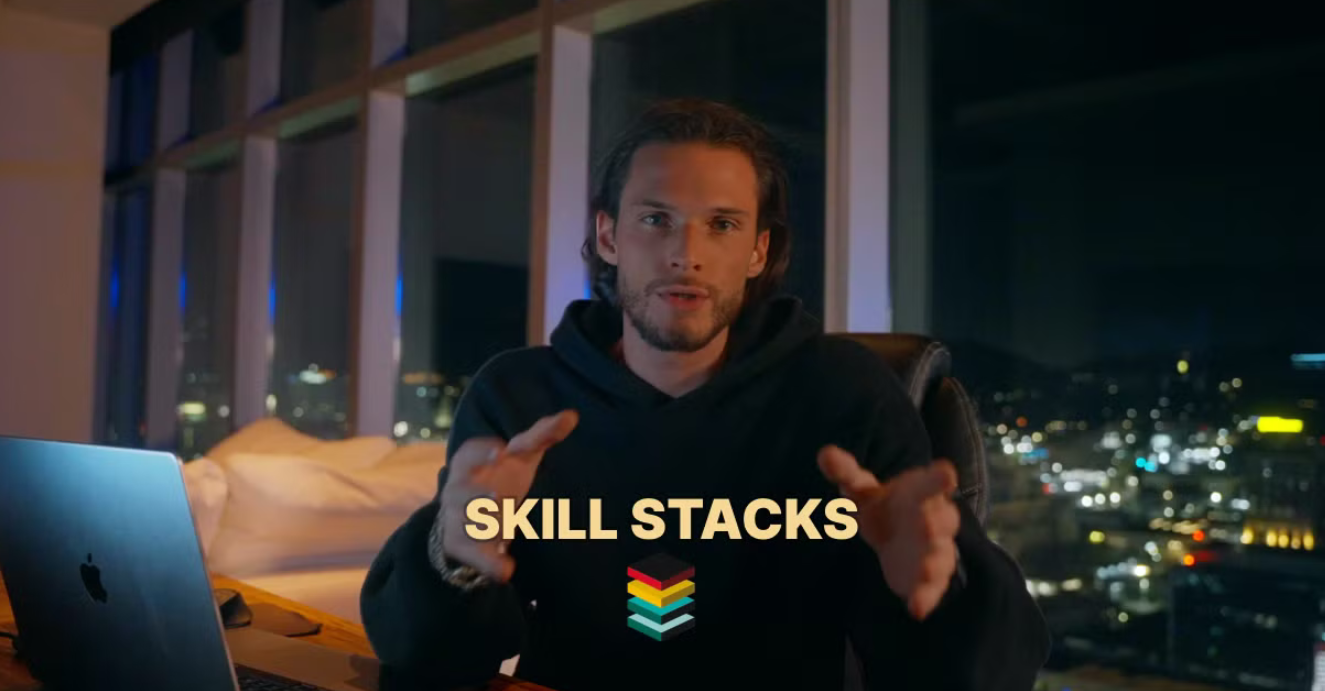
Examples of personal branding used by David
Despite all of his provocative language, David does use some more classic personal branding techniques as well. Across his socials and websites, he has an understated yellow as his brand color.
He also has his own logo that appears across his websites and products, reassuring potential customers that he runs a legitimate business.
9. Ali Abdaal
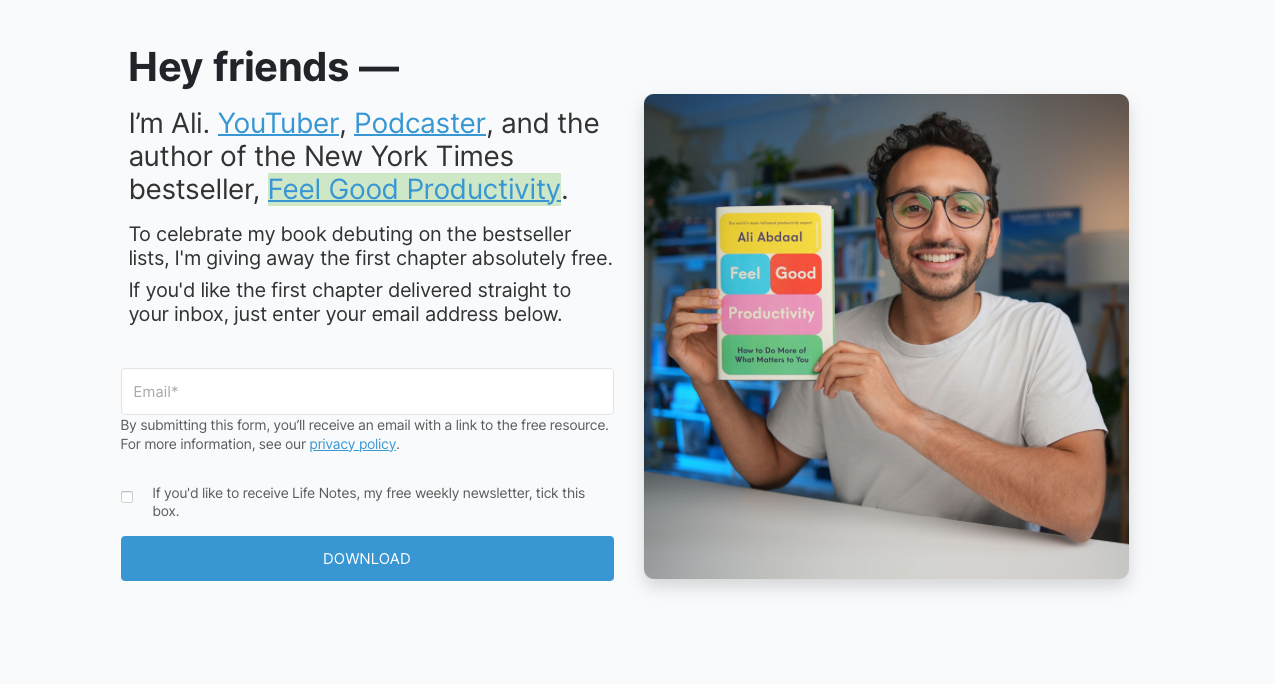
Ali Abaal started out on YouTube and now also has a podcast and a bestselling book. His content focuses mostly on productivity, personal finance, and the pursuit of a more fulfilling life.
He has almost six million subscribers on his main YouTube channel where he covers a variety of topics to help young adults do life better.
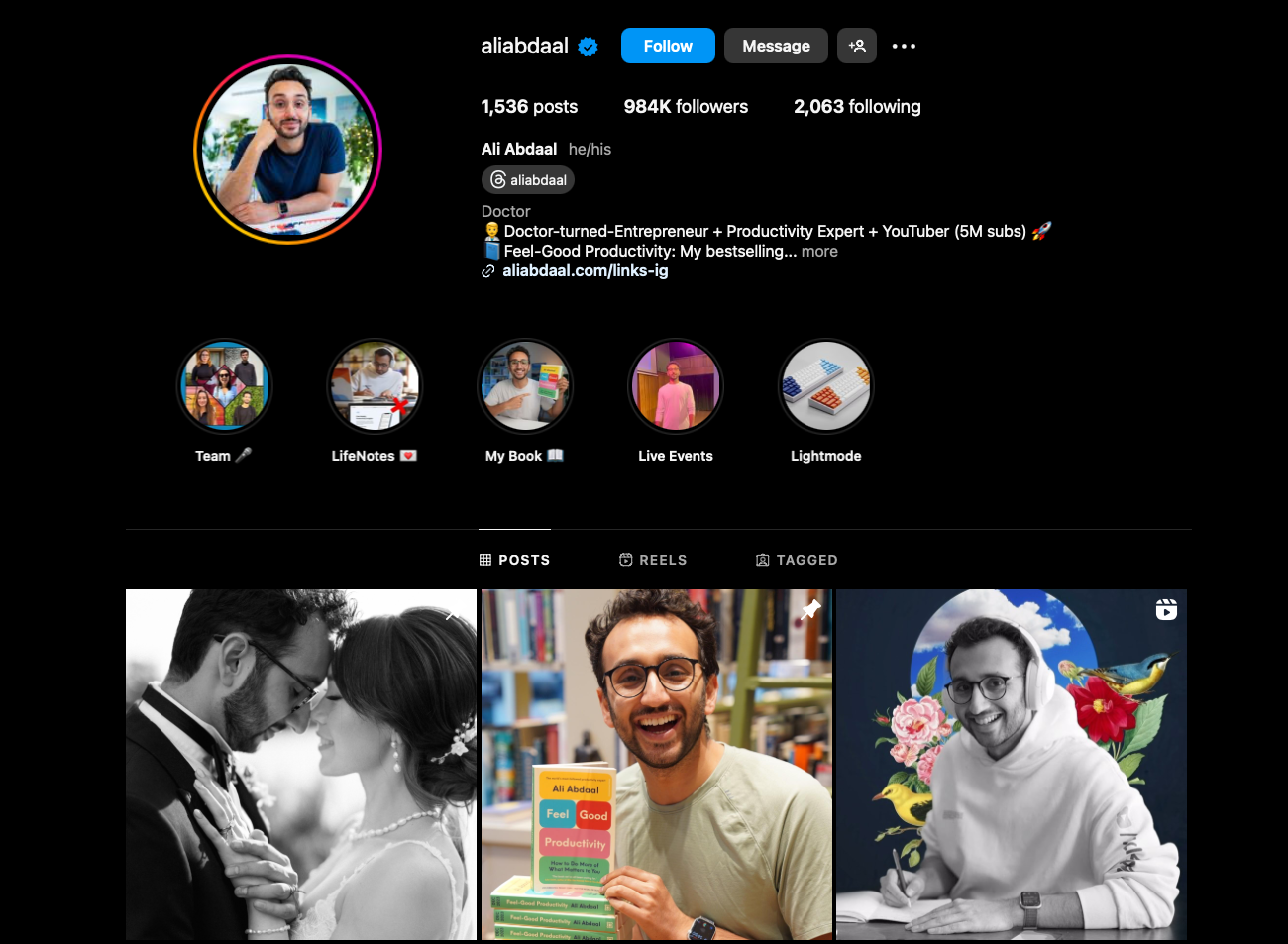
What makes Ali’s brand stand out
Ali’s brand stands out because it’s relatable, educational, transparent, and authentic. Like many entrepreneurs, he started off in a different industry and succeeded in pivoting to something that suited him better.
Being honest about this process and sharing how he succeeded is the biggest part of both his brand and his product.
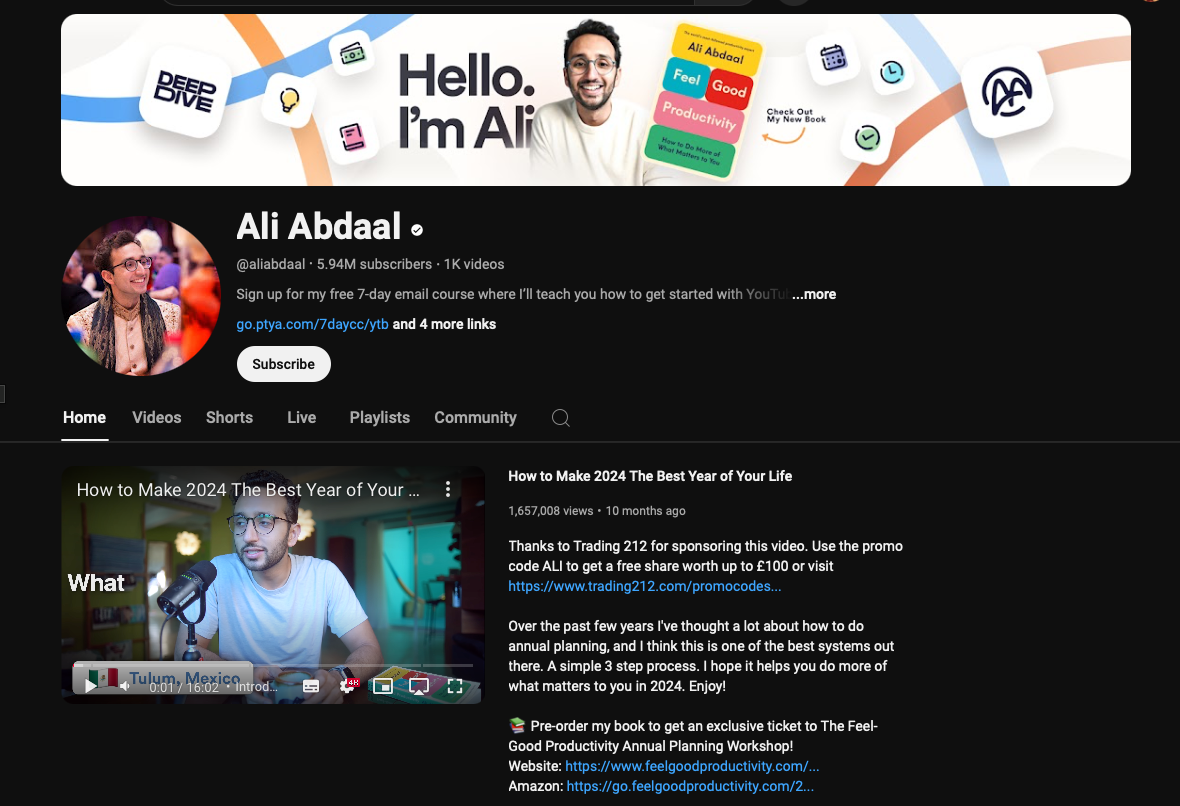
Examples of personal branding used by Ali
Ali has a consistent style across his websites and socials, with a website and a YouTube banner that match the style of his book’s front cover. He also uses a lot of yellow and white text in the thumbnails for his videos.
Ali’s open and honest use of language is also important for his branding as he discusses his own journey and struggles. This helps present him as a genuine person whose advice comes from a real desire to help people.
10. Julian Goldie
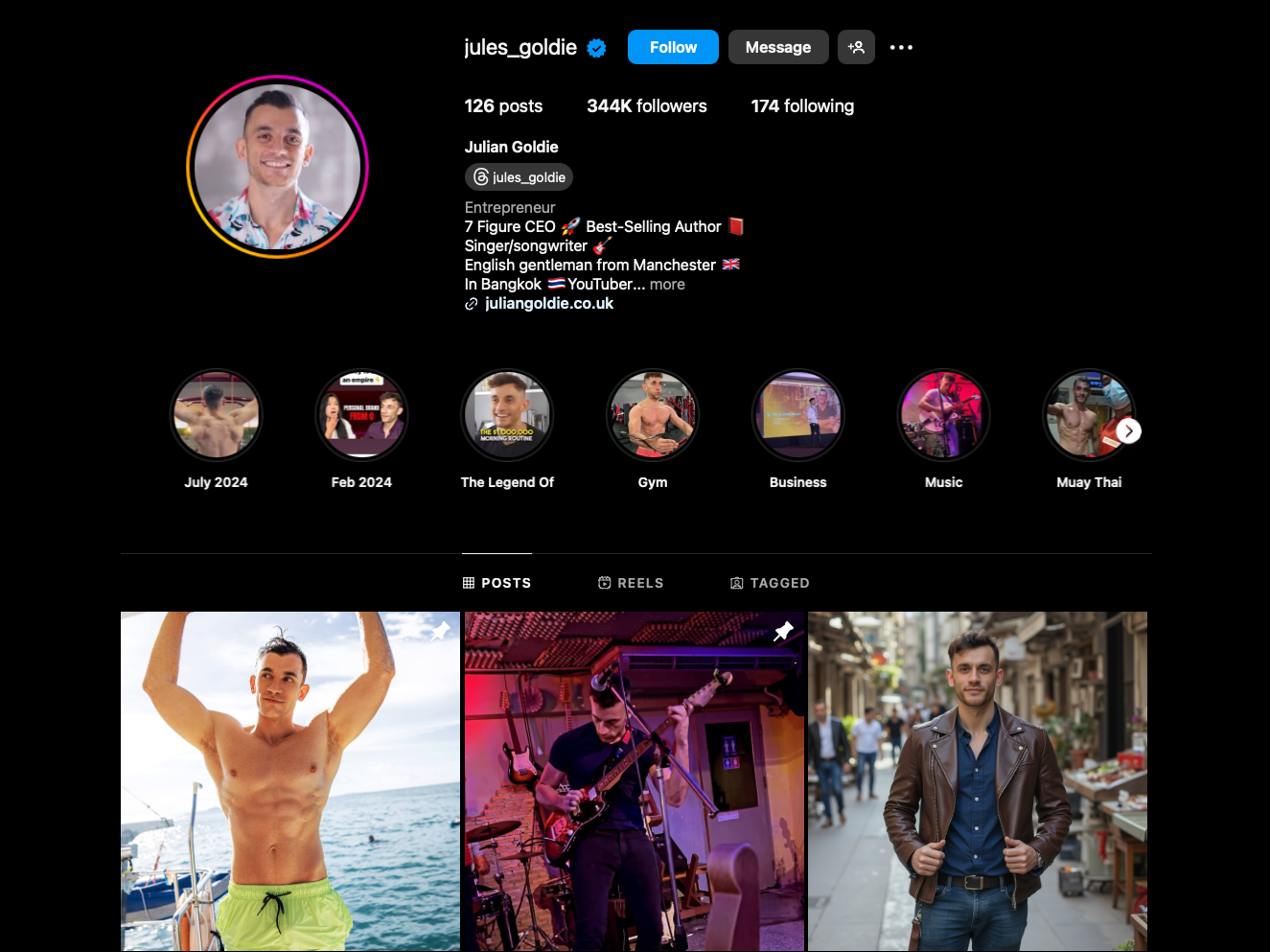
Julian Goldie is an SEO consultant and link-building expert who helps businesses enhance their search engine visibility and drive organic traffic.
His agency provides tailored SEO strategies focused on backlinks and ranking improvements so businesses can grow their online presence.
His educational content on YouTube breaks down complex SEO topics into accessible guides. Most of all, he runs an exclusive SEO community on Whop where members can access courses, resources, and networking contacts.
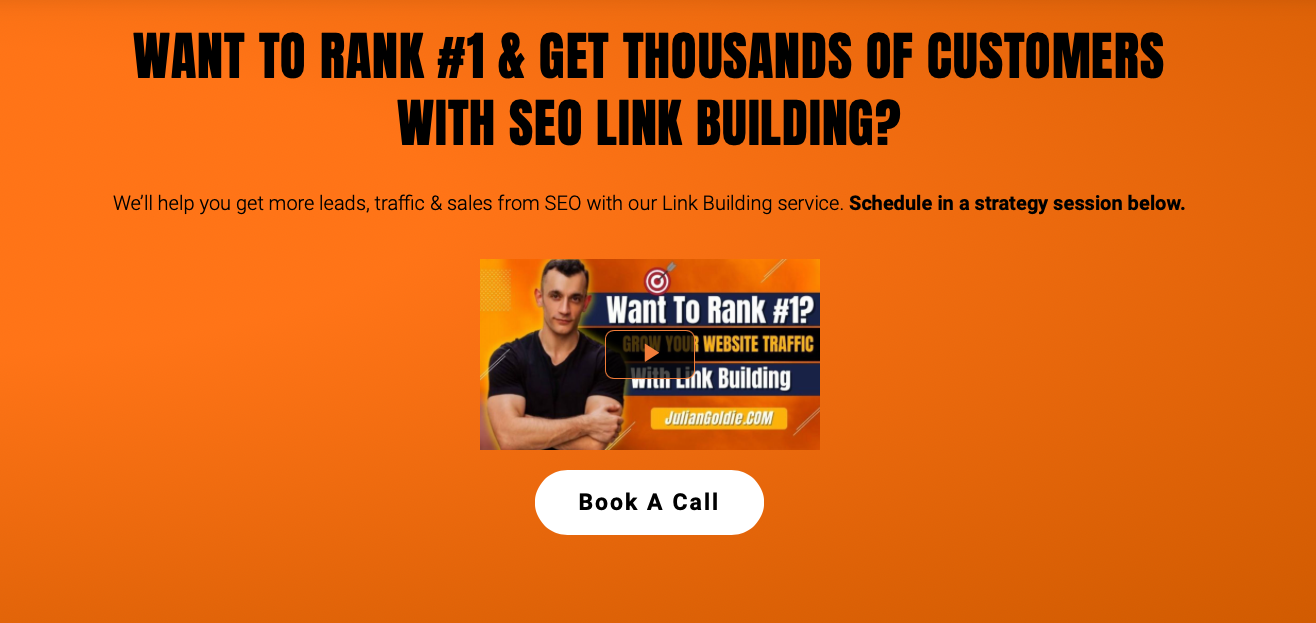
What makes Julian’s brand stand out
Julian has 344,000 followers on Instagram, where he posts a mixture of content related to his life and his business. He doesn’t show off his lifestyle directly as a part of his product but his Instagram still has the same effect—just a little more subtle.
It helps give his brand a professional and legitimate impression, with his results-oriented messaging giving people a simple and compelling reason to trust his business.
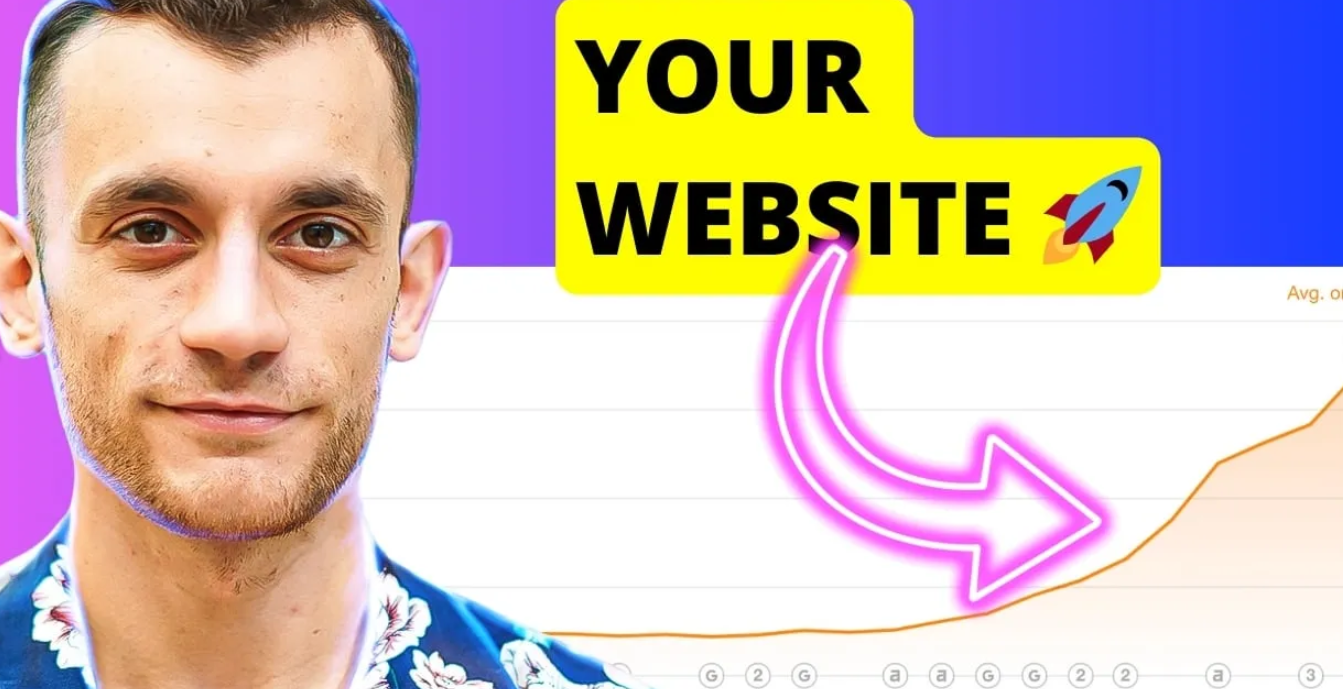
Examples of personal branding used by Julian
Julian uses some color branding across his socials and website, with a bright orange theme and logo. Many of his video thumbnails also use this brand color, creating a consistent and professional feel.
Julian also uses the same profile picture across his socials, which makes his accounts instantly recognizable and easy to spot.
11. Ryan Trahan
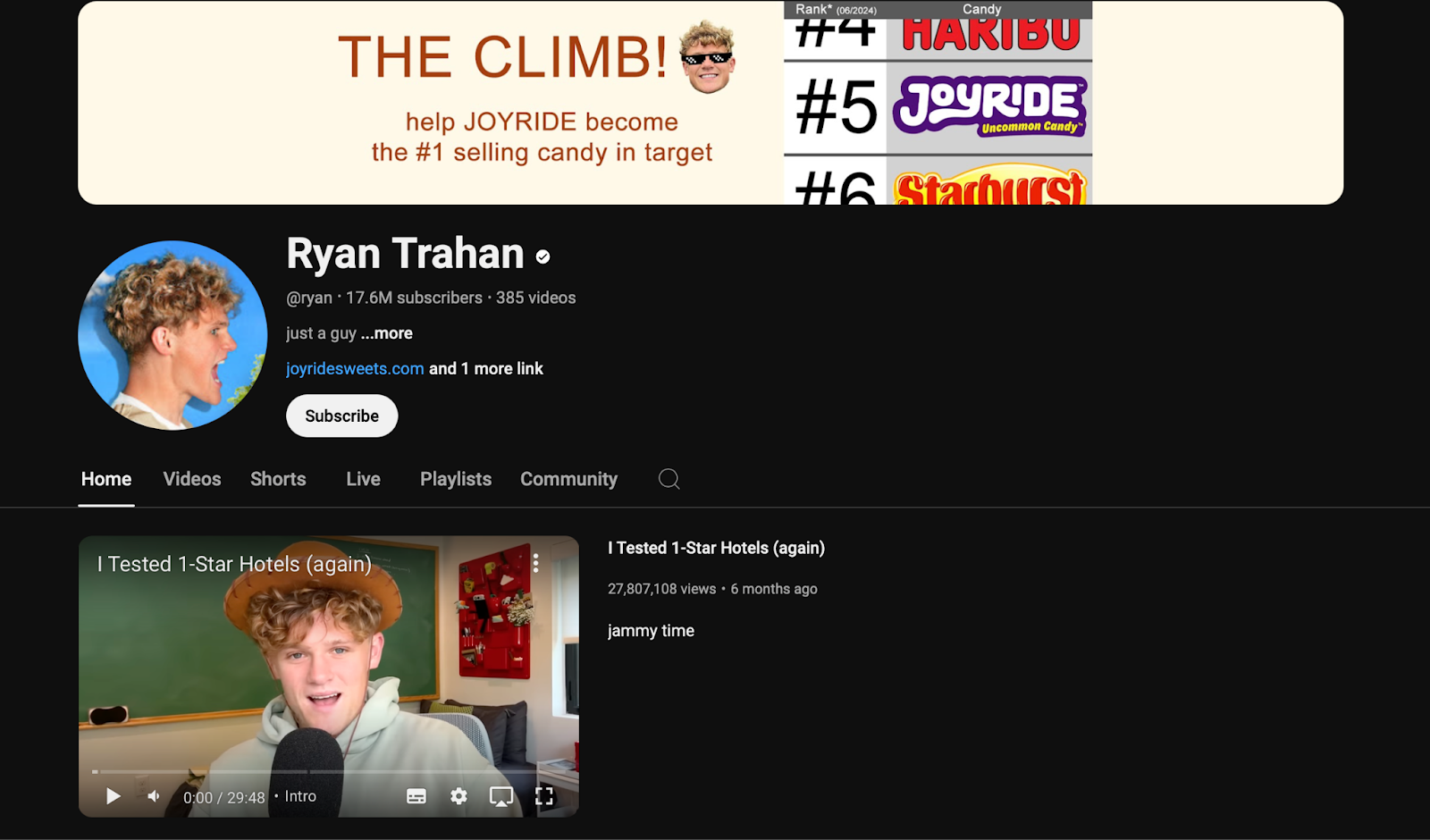
Ryan Trahan is a YouTuber known for his comedic storytelling, challenge videos, and philanthropic projects. His engaging, long-form content often highlights endurance-based or charity-focused challenges, blending entertainment with social good.
Ryan has also expanded his influence into entrepreneurial ventures, including Joyride Sweets, a low-sugar candy brand. His YouTube channel has over 17 million subscribers and he collaborates with many other successful creators.
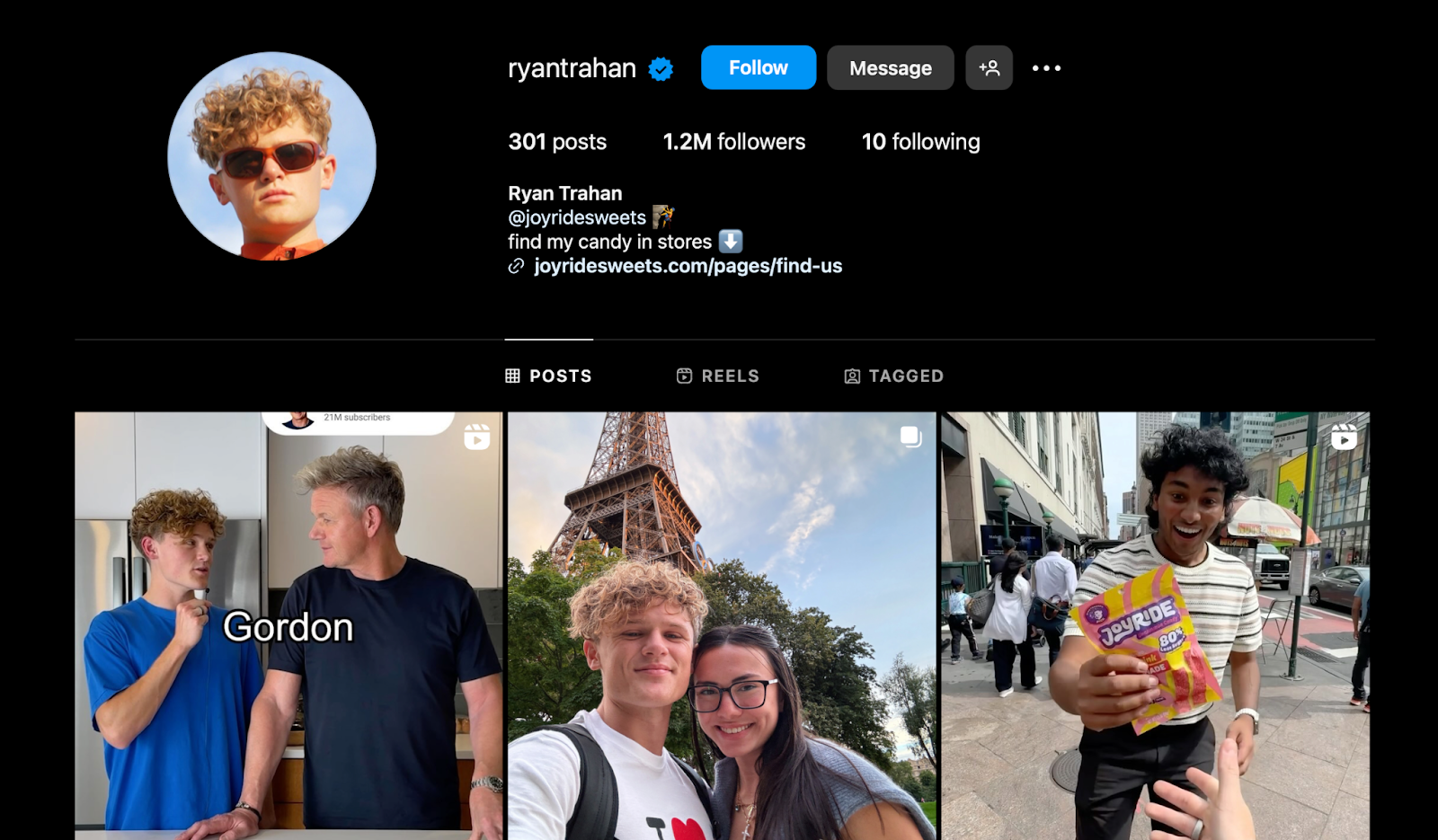
What makes Ryan’s brand stand out
Trahan’s brand stands out through its authenticity and relatability. His storytelling and commitment to challenges (e.g., his "Penny Series" challenge) capture viewers' attention by showing perseverance and humor.
He balances humor with compassion, which resonates well with his audience, especially in his charity-focused videos.
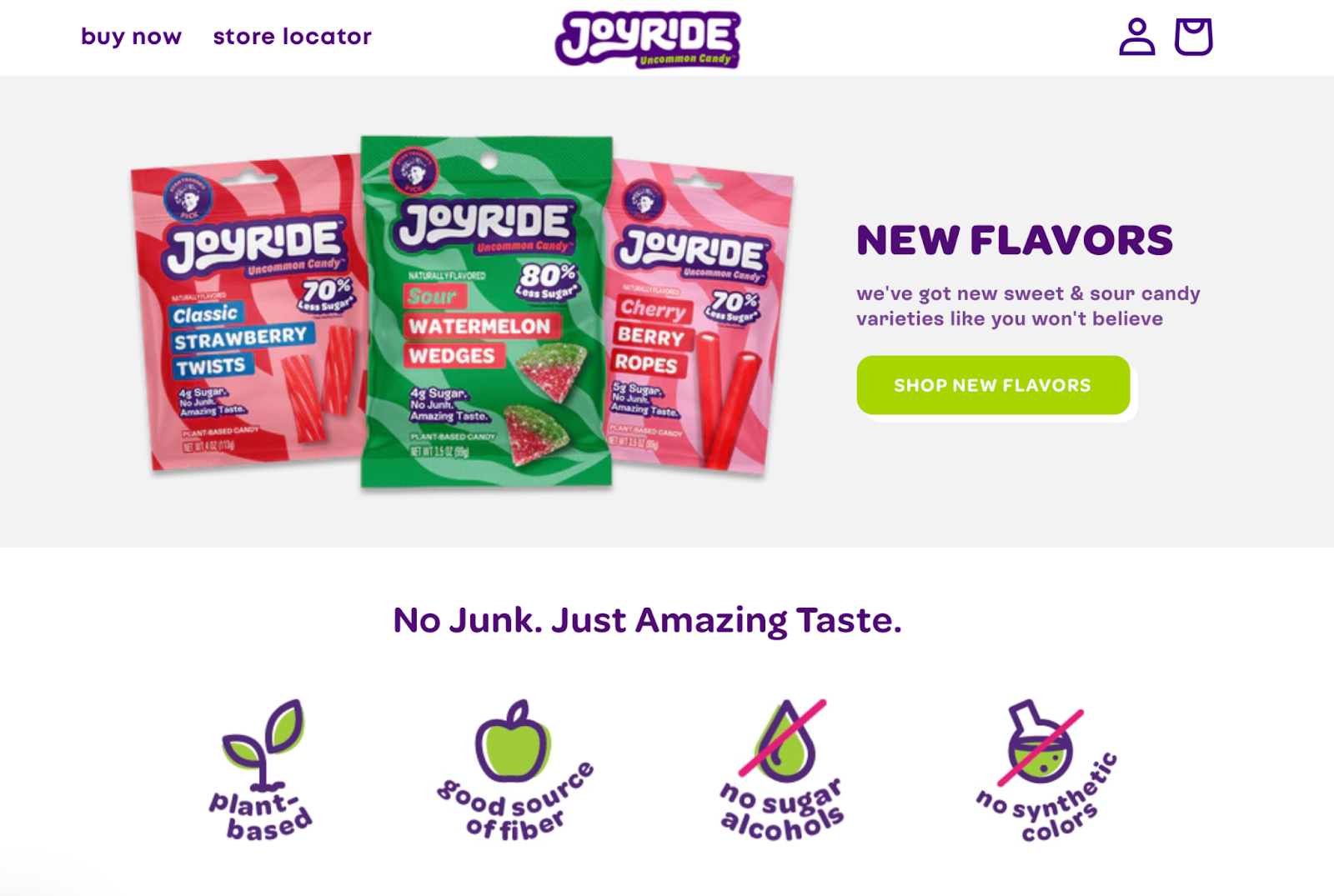
Examples of personal branding used by Ryan
Ryan shows consistency in his projects, with some of his YouTube series lasting multiple years. These series, such as the Penny series, have become a core part of his brand and some of his most-watched videos.
His company, Joyride Sweets, also reflects his values by appealing to a health-conscious yet fun-loving demographic.
12. Henry Wang
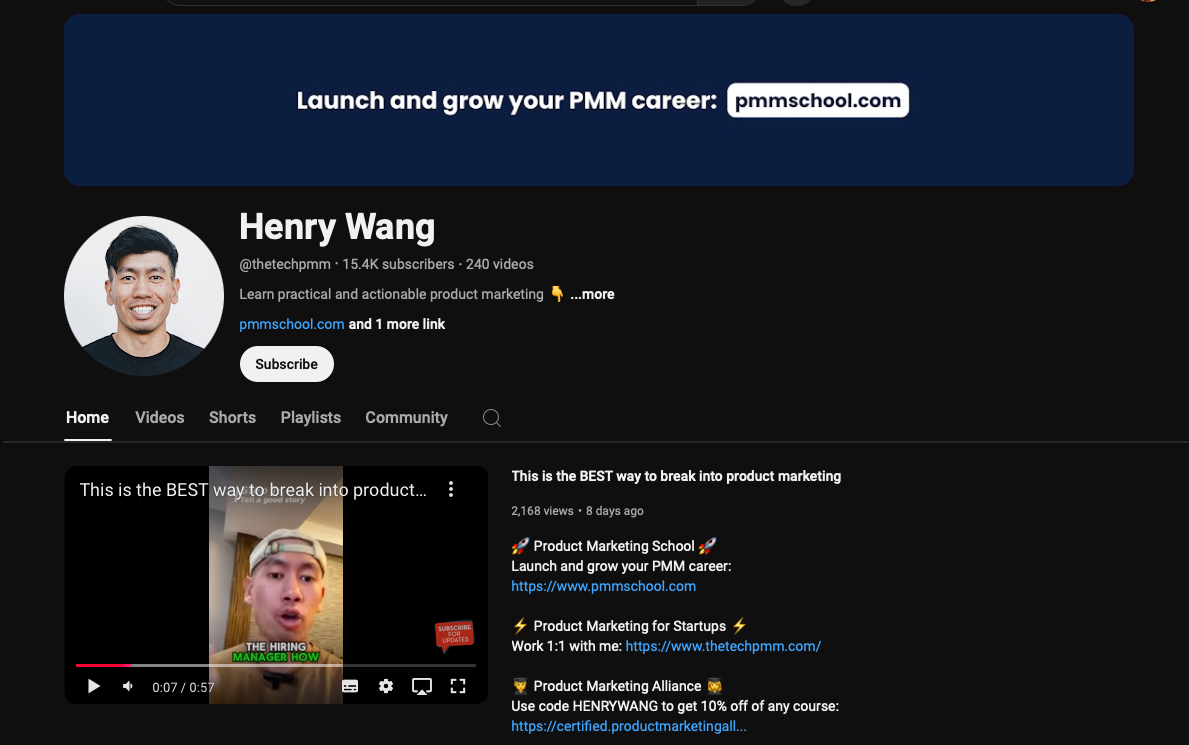
Henry Wang is a product marketing professional who educates others on breaking into the field.
He draws from his experience as a former Google PMM and startup leader, providing online courses and resources for aspiring product marketing managers (PMMs) through his Product Marketing School.
He also hosts his school on Whop, where you can get access to exclusive new content and monthly one-on-one coaching calls with the man himself.
What makes Henry’s brand stand out
Wang’s brand stands out due to its practical, no-nonsense approach to product marketing. Unlike traditional academic courses, his teaching is action-focused, rooted in real-world experience, and tailored for career transitions.
His experience working with Google and four different start-ups shows that he’s used to moving around, handling transitions, and starting new projects.
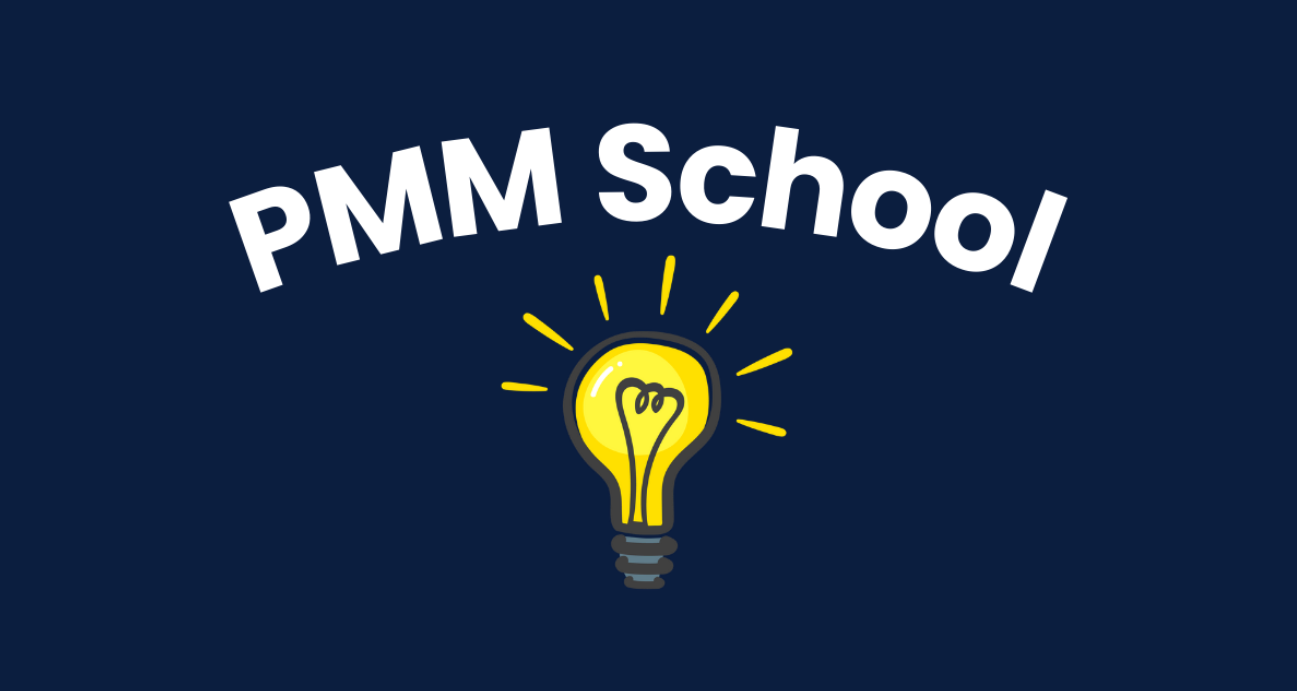
Examples of personal branding used by Henry
The way Henry shares his own success story is a great example of personal branding.
He has cemented himself in the PMM industry and collected all sorts of insights on what employers look for, making him an expert in this niche.
On his YouTube, he sticks to simple thumbnails with matching fonts and titles to create cohesion and make his videos look professional and high-effort.
13. Sam Altman
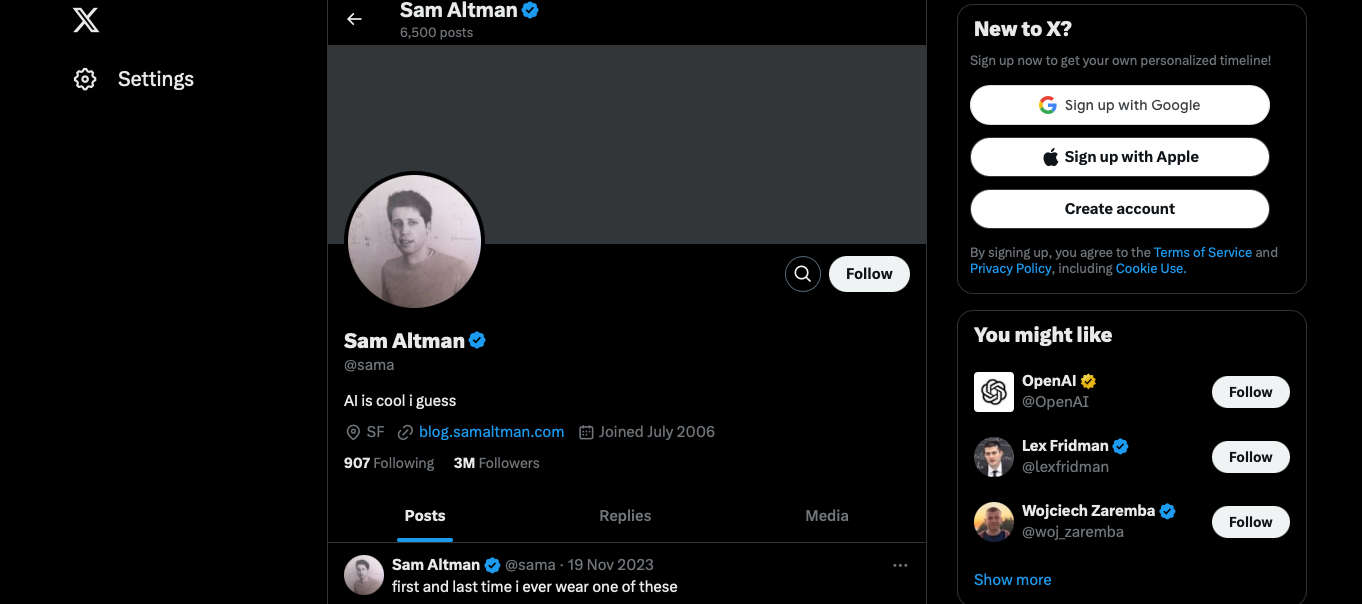
Sam Altman is the CEO of OpenAI and a prominent figure in the tech industry, with a background in startups, venture capital, and AI.
As OpenAI's CEO, he advocates for the ethical and responsible development of artificial intelligence, balancing innovation with global safety. He has three million followers on X and runs his own blog.
What makes Sam’s brand stand out
Sam’s brand is all about transparency and ethics, as he positions himself as someone who will both get excited about AI and be truthful about its downfalls.
Until recently, this brand was backed up by the fact that he worked for a non-profit organization but as OpenAI pivots to a different business model, it could affect Sam’s personal branding.
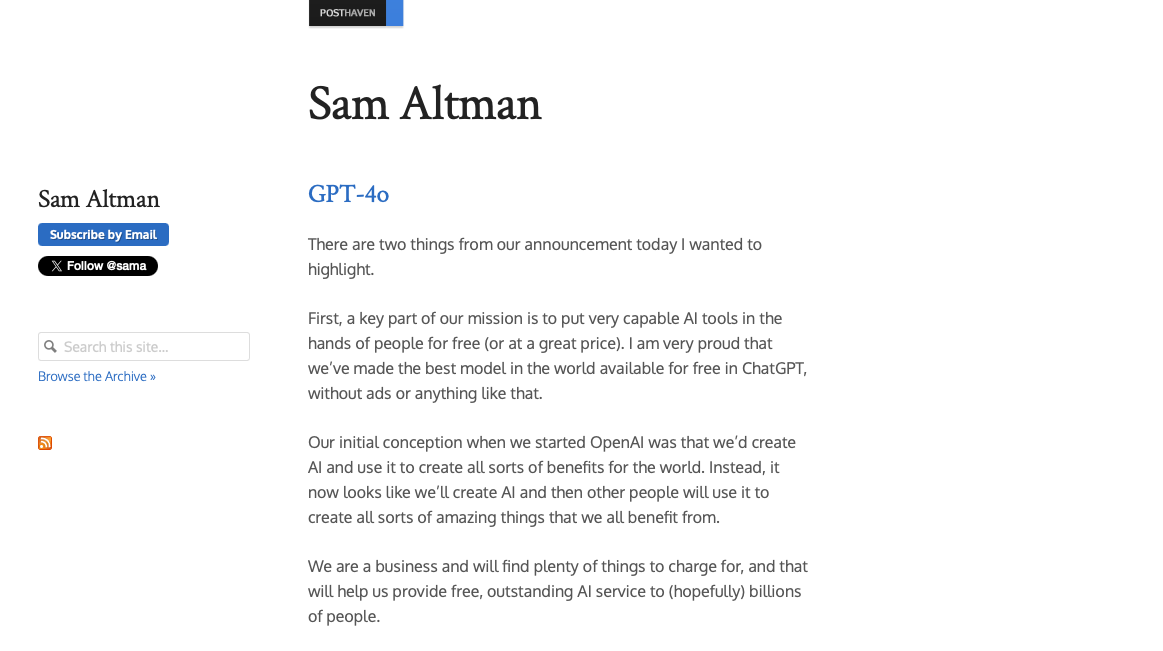
Examples of personal branding used by Sam
Most of Sam’s personal branding is about language. His only social media profile is on X and his blog is extremely minimalist.
What he focuses on instead is presenting his work and his thoughts as clearly and honestly as possible so people can trust him and his views on AI.
14. Zavon Griffin
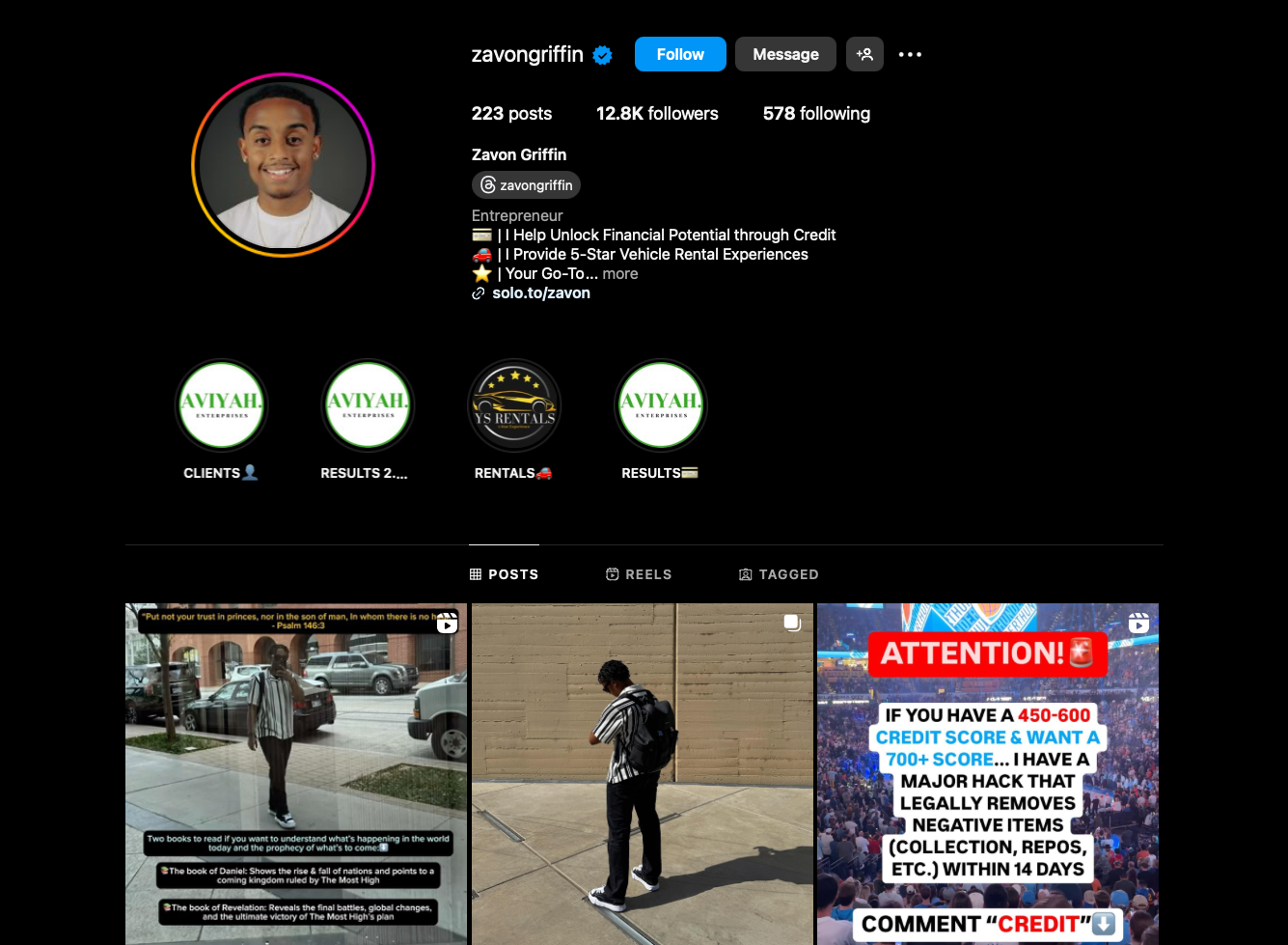
Zavon Griffin is a financial educator and credit consultant who provides customized credit improvement and financial literacy services through his company, Aviyah Enterprise.
His mission focuses on helping people achieve financial stability and freedom through informed credit management. You can also get his help through Whop, where he hosts an online course with customer support.
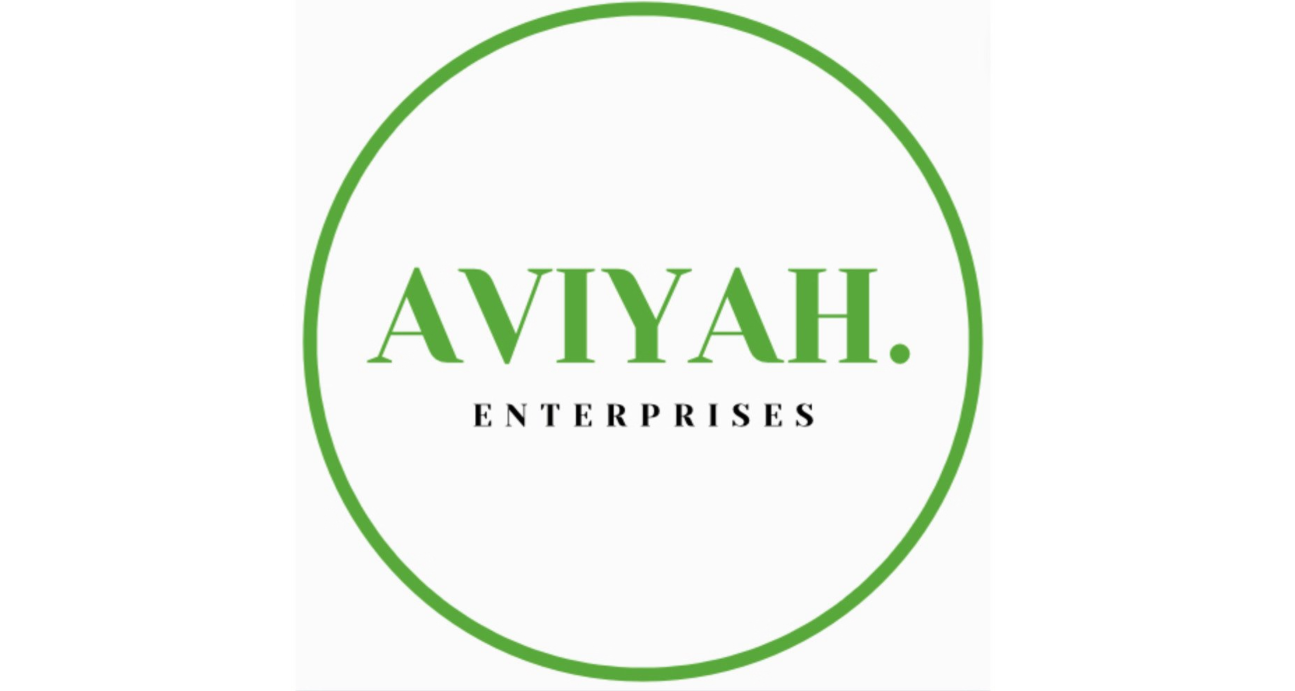
What makes Zavon’s brand stand out
Griffin’s brand is deeply personal, and rooted in his own journey of financial recovery. Aviyah Enterprise emphasizes transparency and a personalized approach. It appeals to people who need customized guidance and long-term help with their finances.
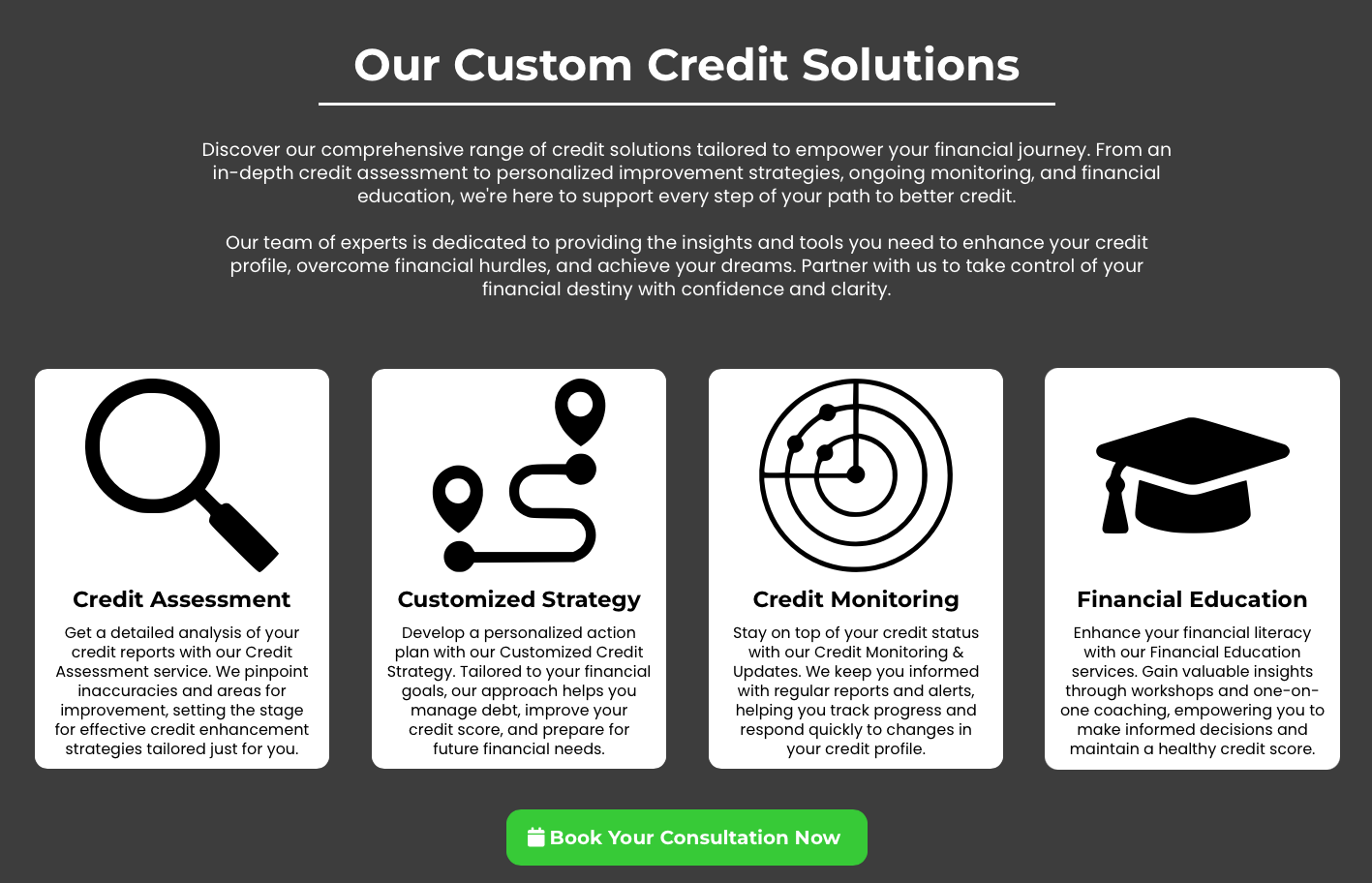
Examples of personal branding used by Zavon
His company is named after his daughter, showing how personal the topic of credit repair is and how much it has changed his own life.
Real people and real results are big parts of his brand, so he showcases a lot of client success stories on his website. That way, people can find out exactly what kind of results they can expect and what kind of experiences others have.
15. Jessica Walsh
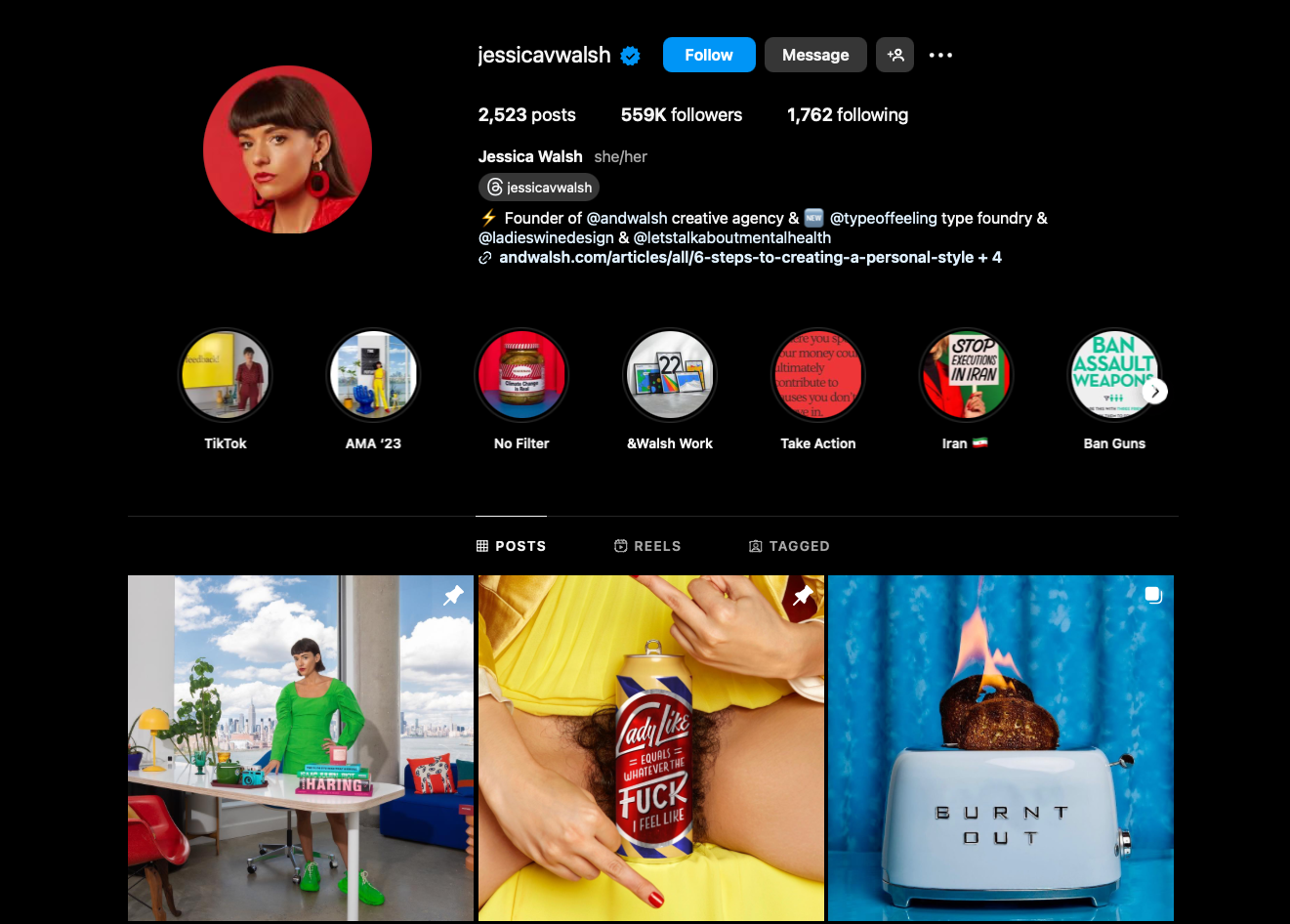
Jessica Walsh is a renowned creative director and designer, leading the New York-based creative agency &Walsh.
Her agency focuses on brand strategy, art direction, and design, producing work for clients like Apple, Levi's, and Adobe.
Walsh’s design style combines bold visuals with emotion-driven storytelling, frequently incorporating societal and emotional themes. She has multiple companies and over 550,000 followers on Instagram.
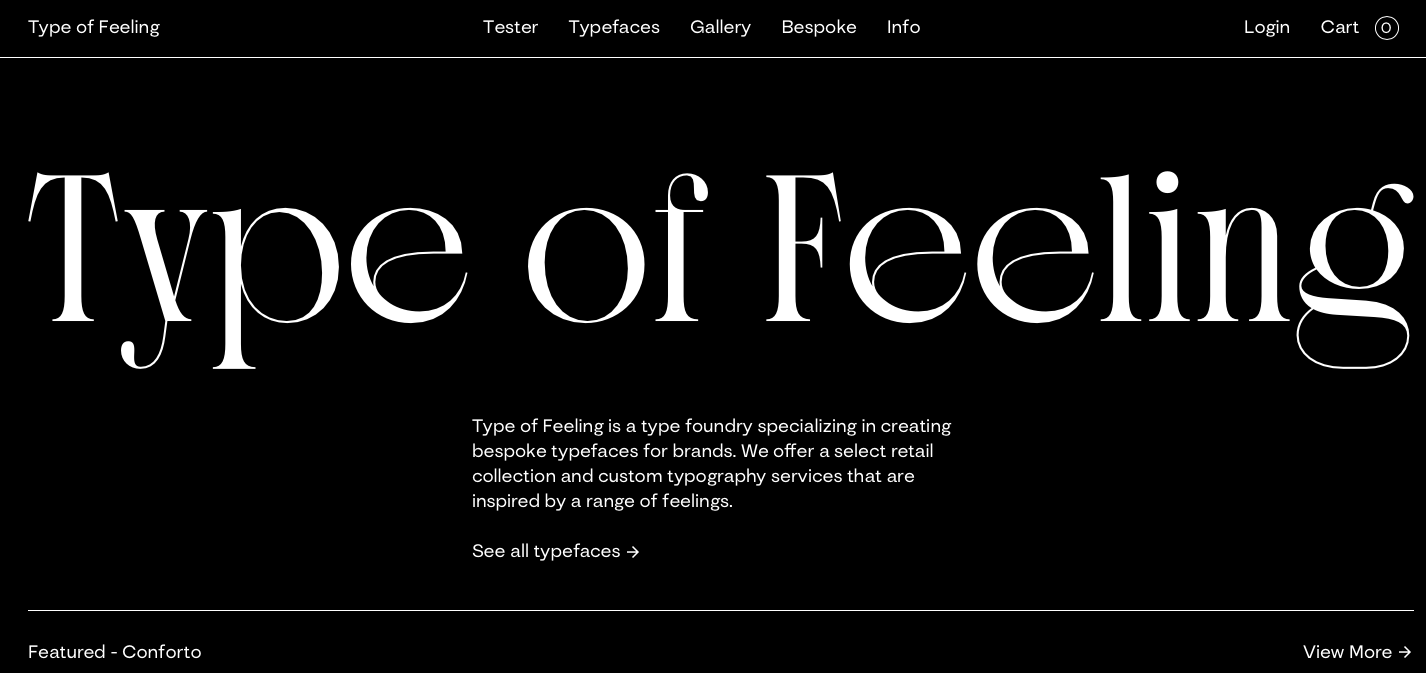
What makes Jessica’s brand stand out
Walsh’s brand is notable for its vibrant, boundary-pushing aesthetic and commitment to inclusivity.
She often uses her platforms to address social issues, merging activism with creative work. Her brand’s visual identity is colorful, emotive, and highly original, setting her apart in the design world.
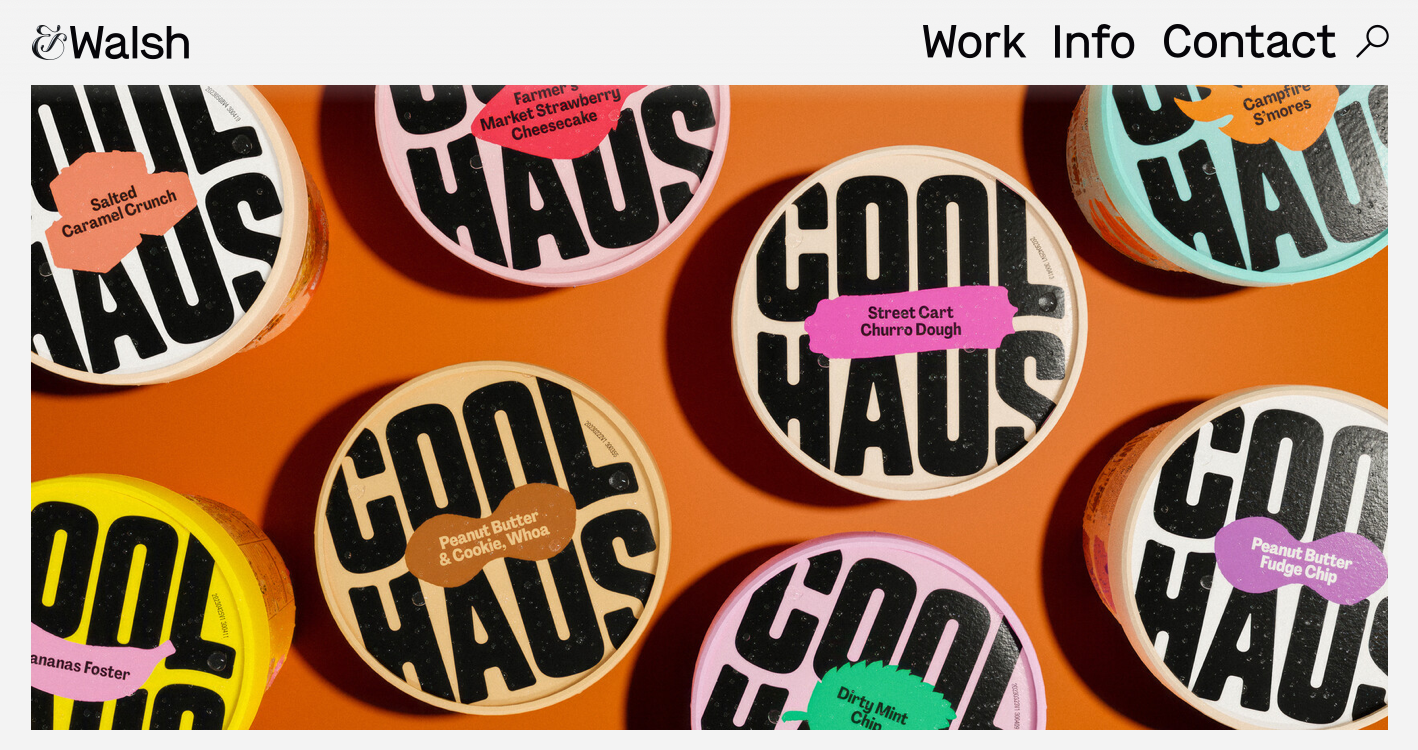
Examples of personal branding used by Jessica
Jessica’s distinctive visual identity is all over her work, but each project is also completely unique and suited to the client’s brand.
Because she’s so associated with bold designs and bright colors, people instantly think of her when they see a design that fits the bill.
16. Teacher Ash
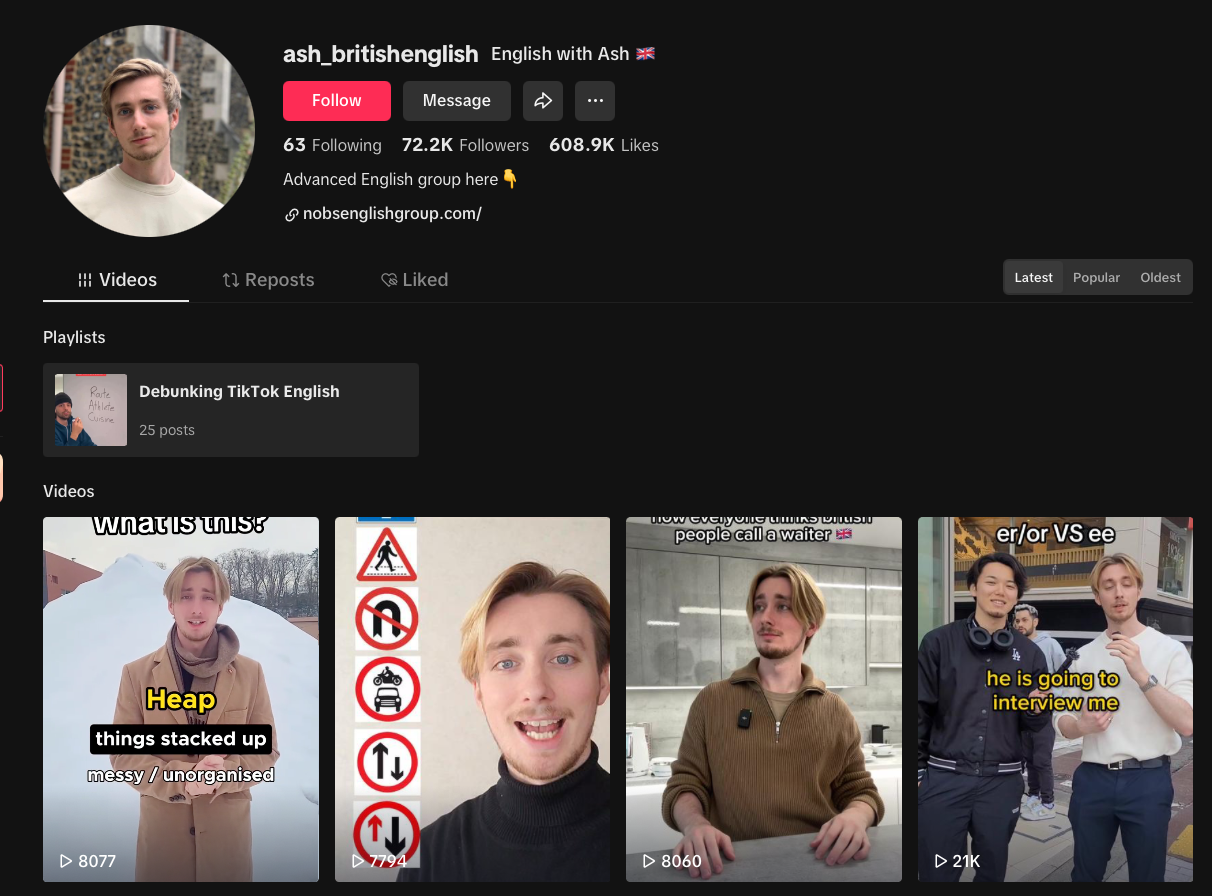
Ash is an English teacher who specializes in British English, providing online resources and lessons through social media and the No B.S. English Group for advanced learners.
He aims to help students and teachers reach fluency and deepen their understanding of English. His main social network is Instagram where he has over 850,000 followers. His school is also available on Whop where he hosts live seminars.
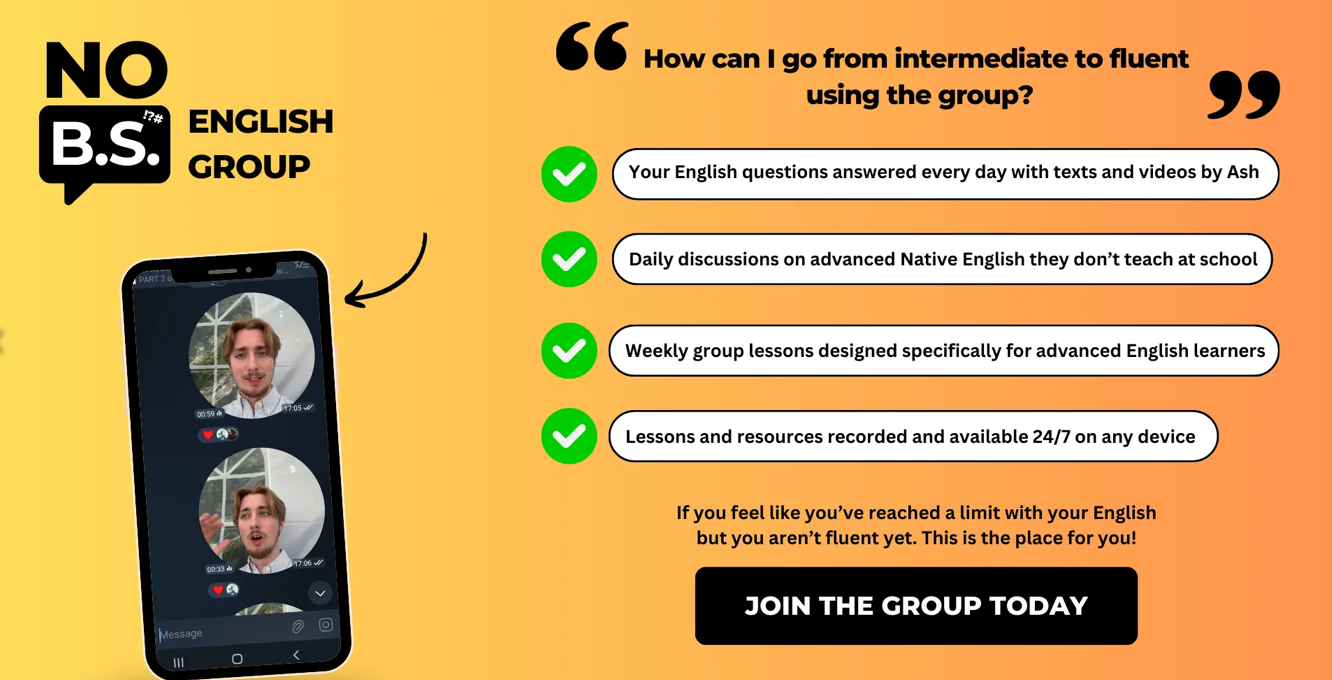
What makes Ash’s brand stand out
Ash’s brand stands out thanks to his practical, straightforward approach (after all, it's called "No B.S." for a reason) that appeals to advanced learners. His materials focus on nuanced language usage, especially for high-level non-native speakers and English teachers.
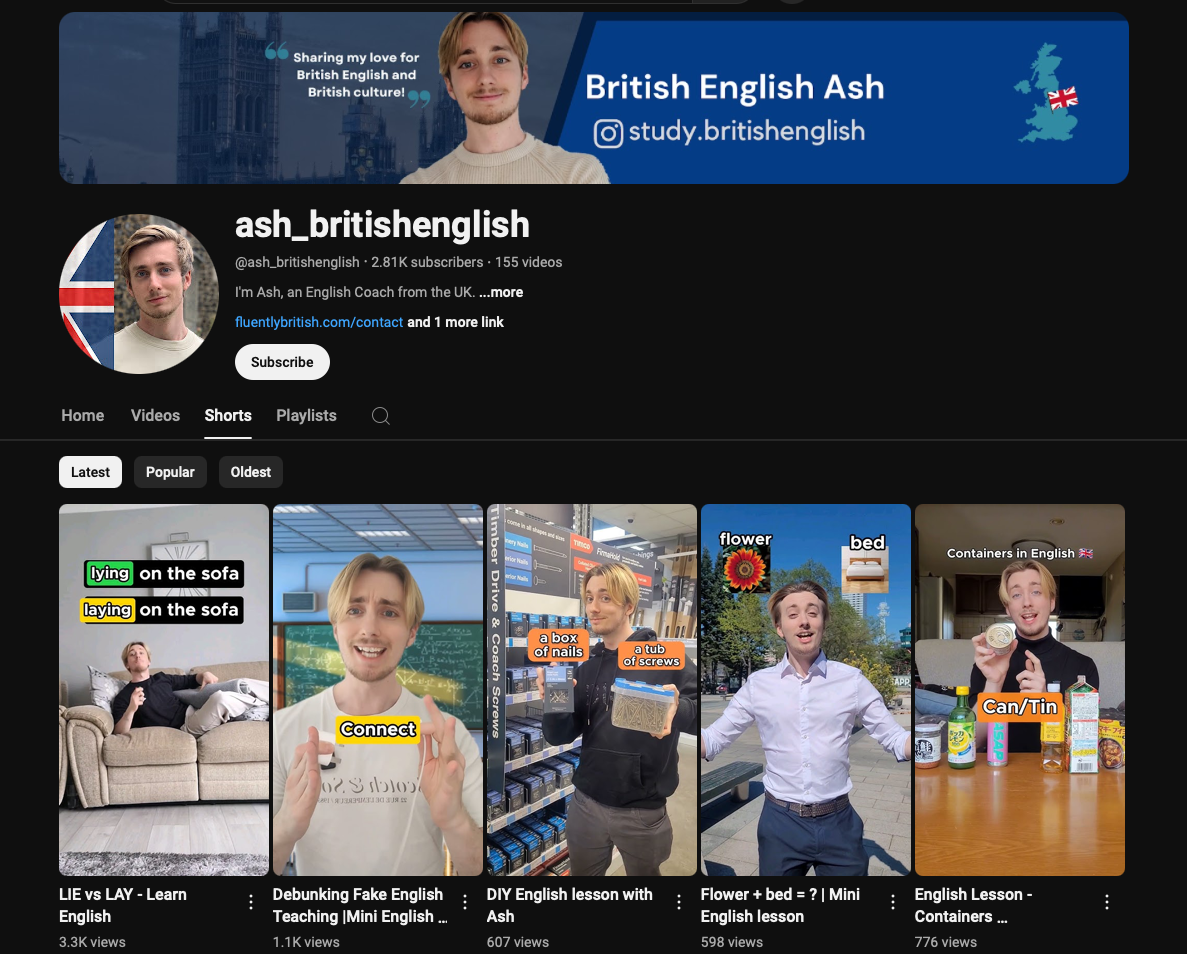
Examples of personal branding used by Ash
Language learning combines lots of different types of study and Ash reflects this with his platform-specific content.
He does tutorials on YouTube, quick tips on Instagram, and in-depth, super personalized guidance on Whop.
17. Cassey Ho
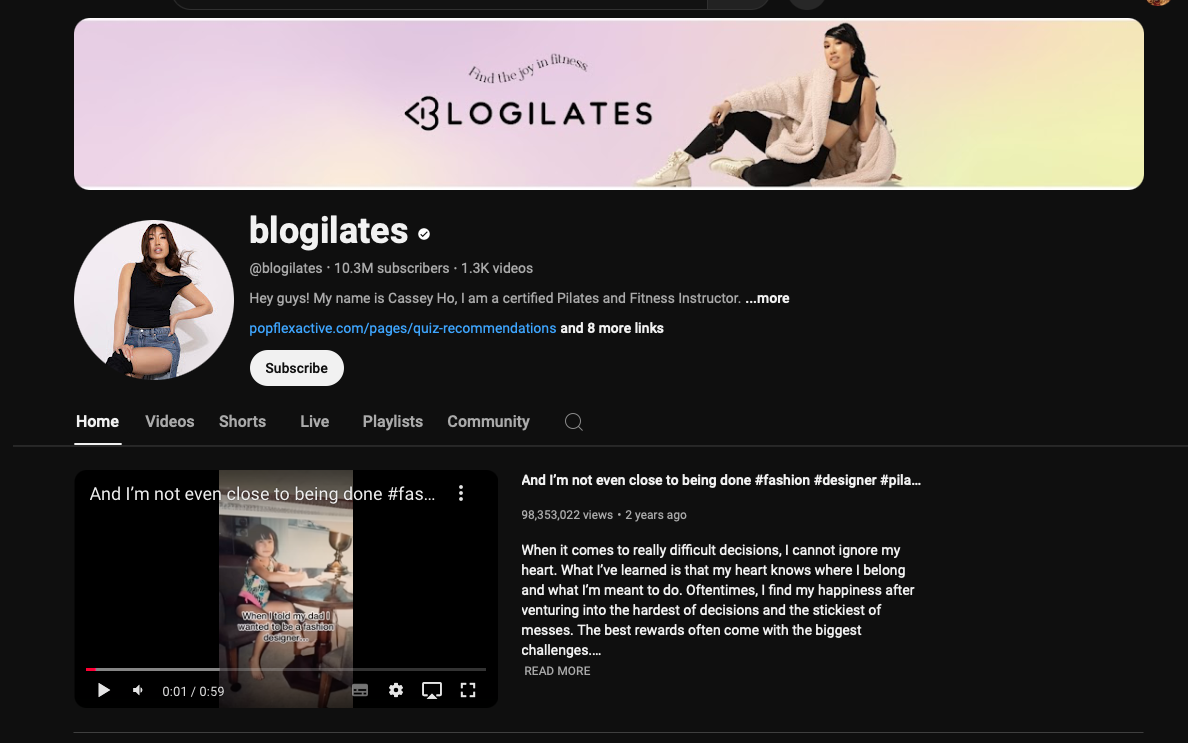
Cassey Ho is a fitness influencer and instructor who founded Blogilates, a popular online platform for Pilates-inspired workouts, wellness, and fitness-related products.
She offers free workout videos on YouTube and runs Popflex, an activewear and fitness gear brand. She has over 10 million subscribers on YouTube as well as millions across other platforms as well.
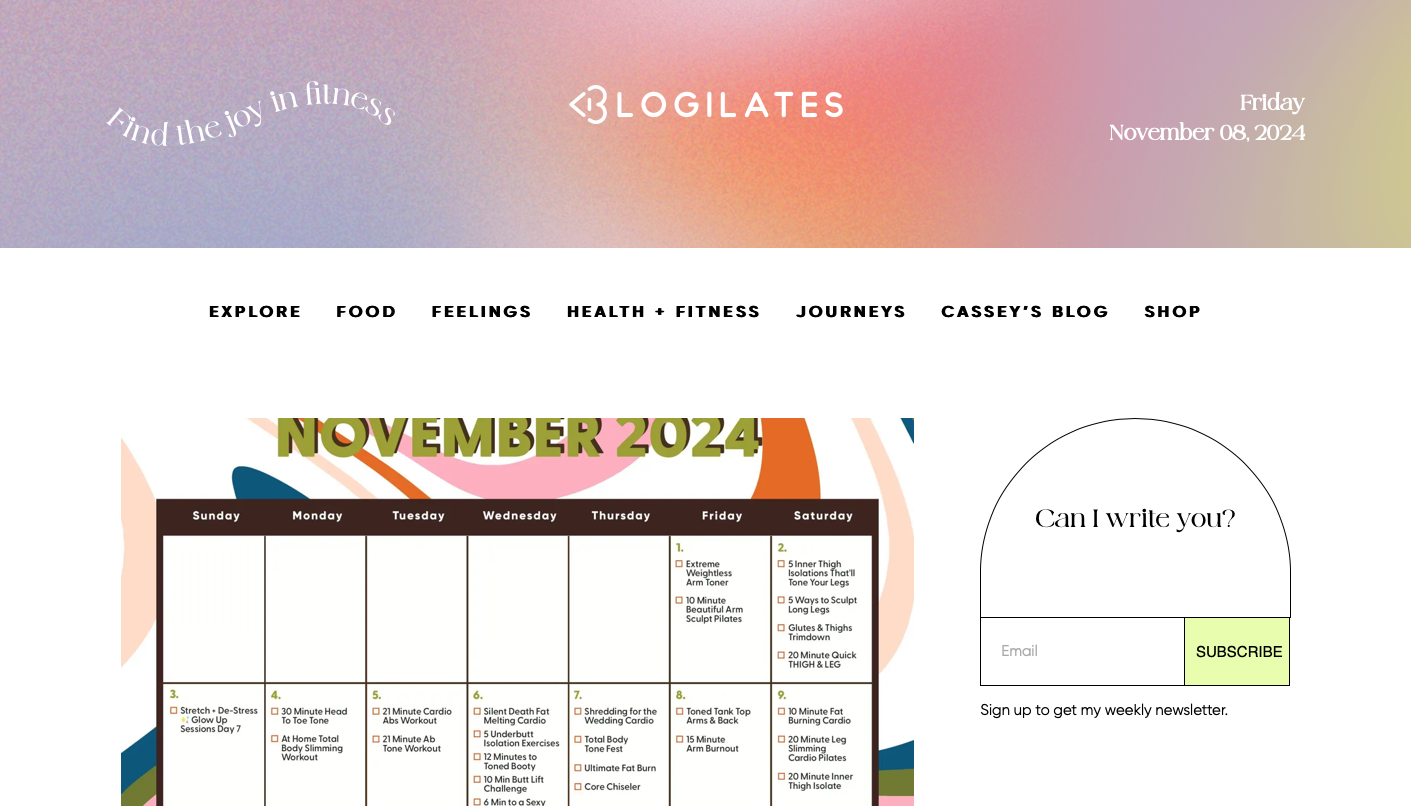
What makes Cassey’s brand stand out
Her brand combines approachable fitness routines with a strong sense of community and body positivity. Cassey’s positive, motivational style encourages inclusivity in fitness, making it accessible for people at all levels.
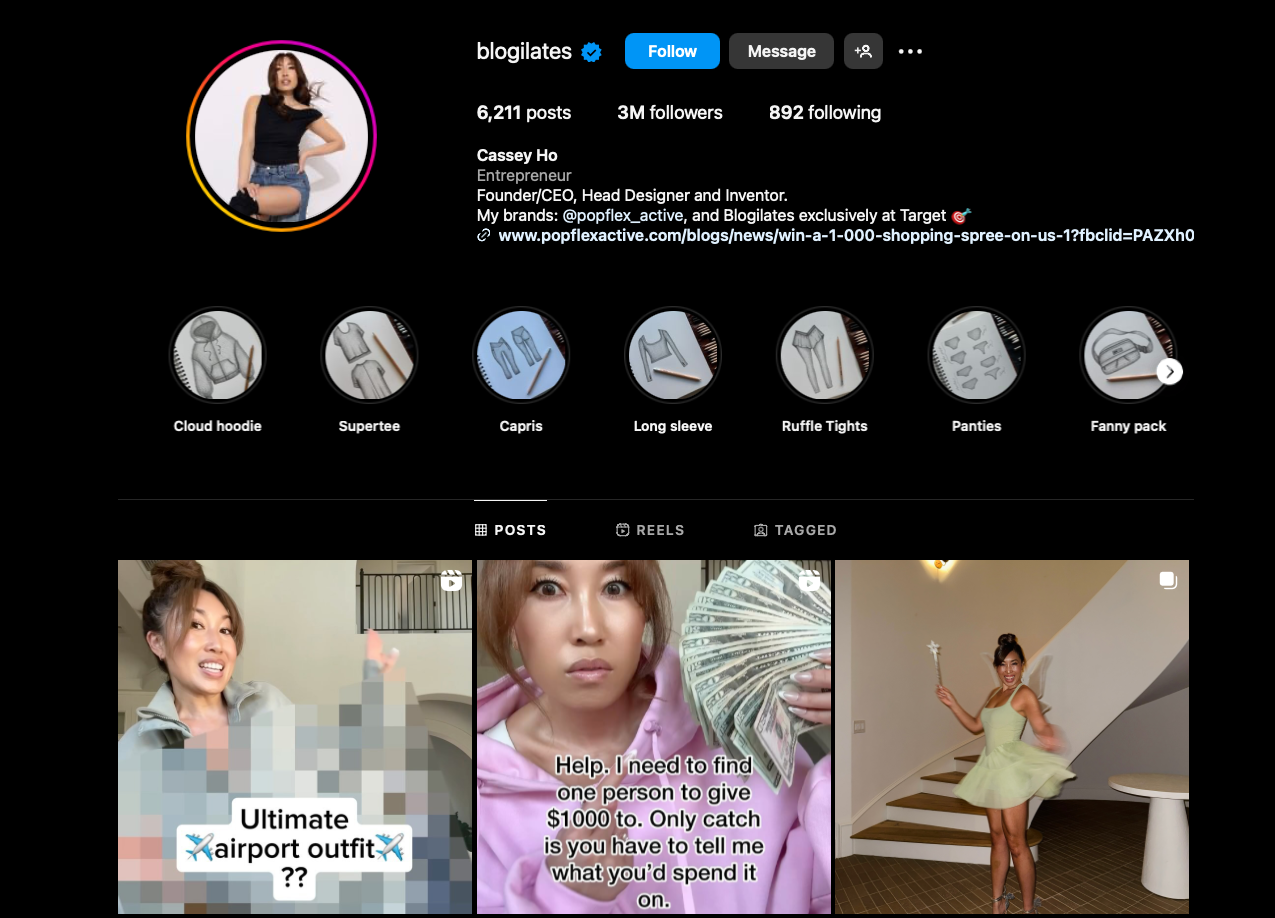
Examples of personal branding used by Cassey
Cassey puts a lot of emphasis on the creative and manufacturing process of her clothing lines, showing her sketches, prototypes, and thought processes regularly.
She’s also known for making changes to her products based on the comments she gets on social media.
18. Thomas Kralow
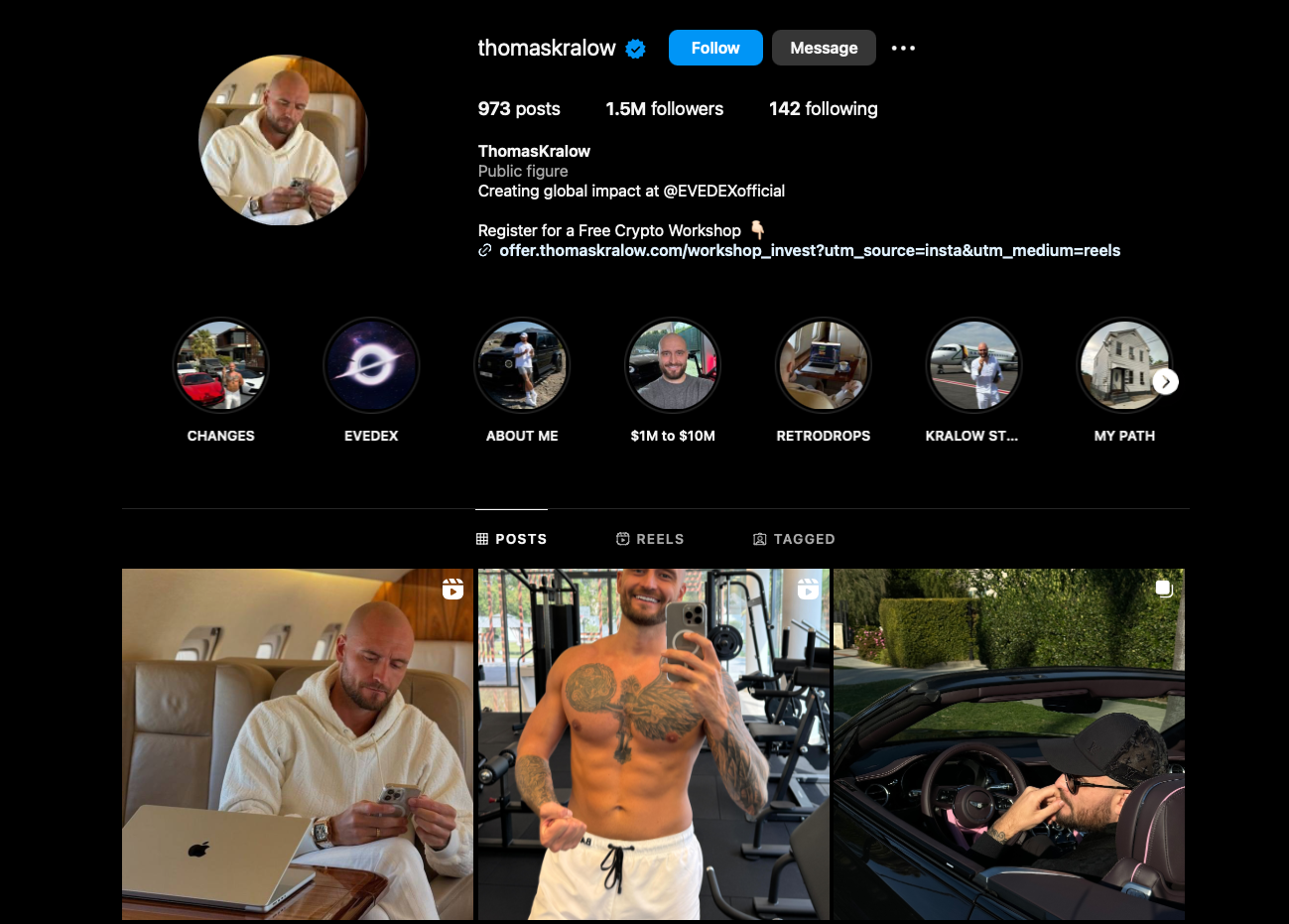
Thomas Kralow is an educator and entrepreneur who offers finance and wealth-building courses through his platform "Game Changer."
He teaches methods to make money online, covering areas like affiliate marketing, trading, and personal branding. He's all over various socials, and he's got a whopping 1.5 million followers on Instagram.
He also hosts Game Changer on Whop, where you can get access to an exclusive range of online courses, a community, and live streams with experts.
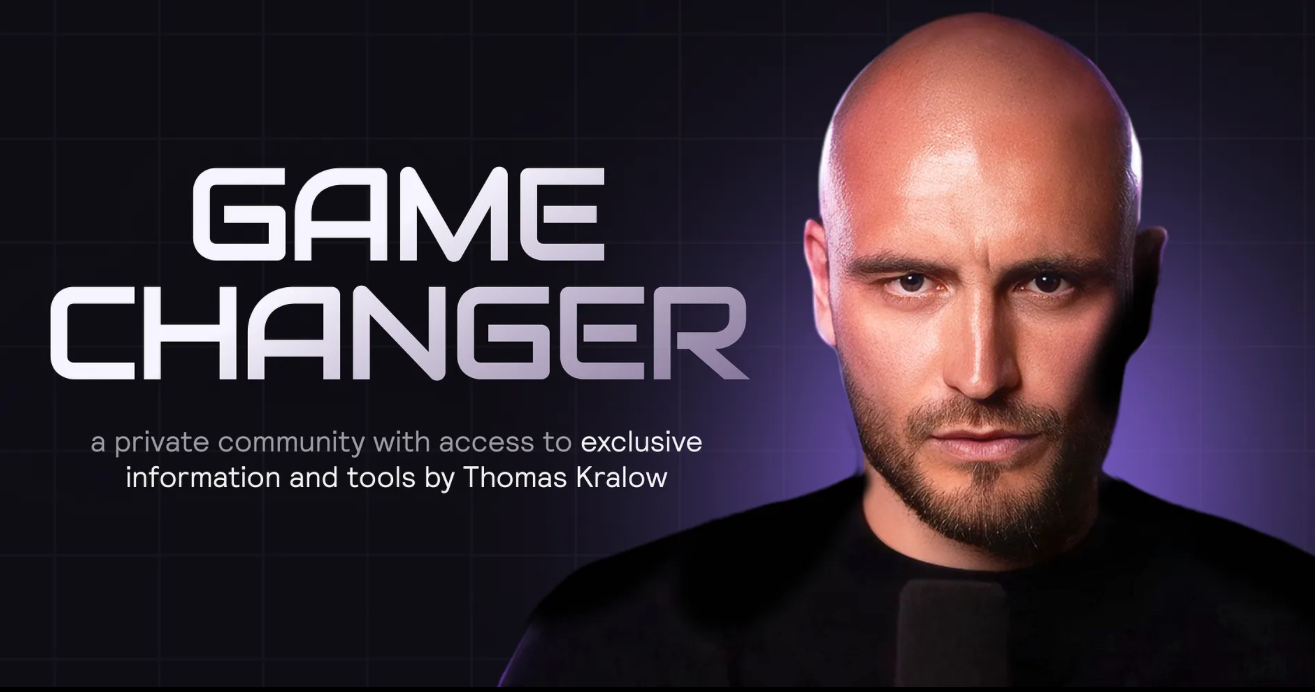
What makes Thomas’ brand stand out
Kralow’s brand is practical and accessible, emphasizing community support and hands-on learning. He's known for demystifying wealth-building methods and providing step-by-step tools and strategies for people who want to change their lives.
As well as covering what works, Kralow also debunks incorrect information or bad strategies to make sure his students don’t fall into any traps and risk their investments.
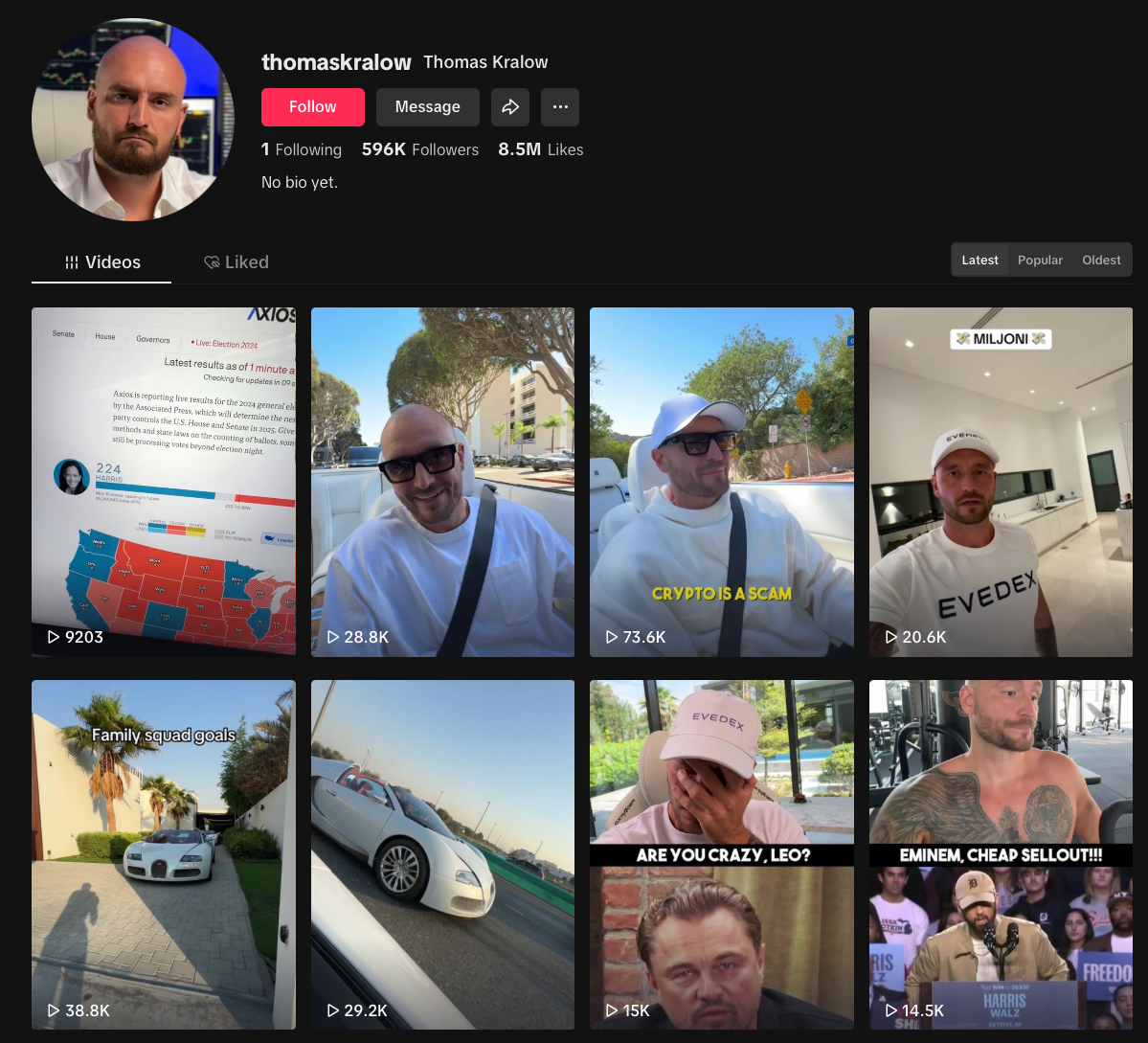
Examples of personal branding used by Thomas
Kralow is very active on social media, constantly sharing tips, addressing current events, and having fun with his followers.
He also gives a glimpse into his own lifestyle which helps to motivate his students and encourages them to set goals for themselves.
He uses the color purple across many of his platforms and also uses similar imagery to create cohesion.
19. Chris Do
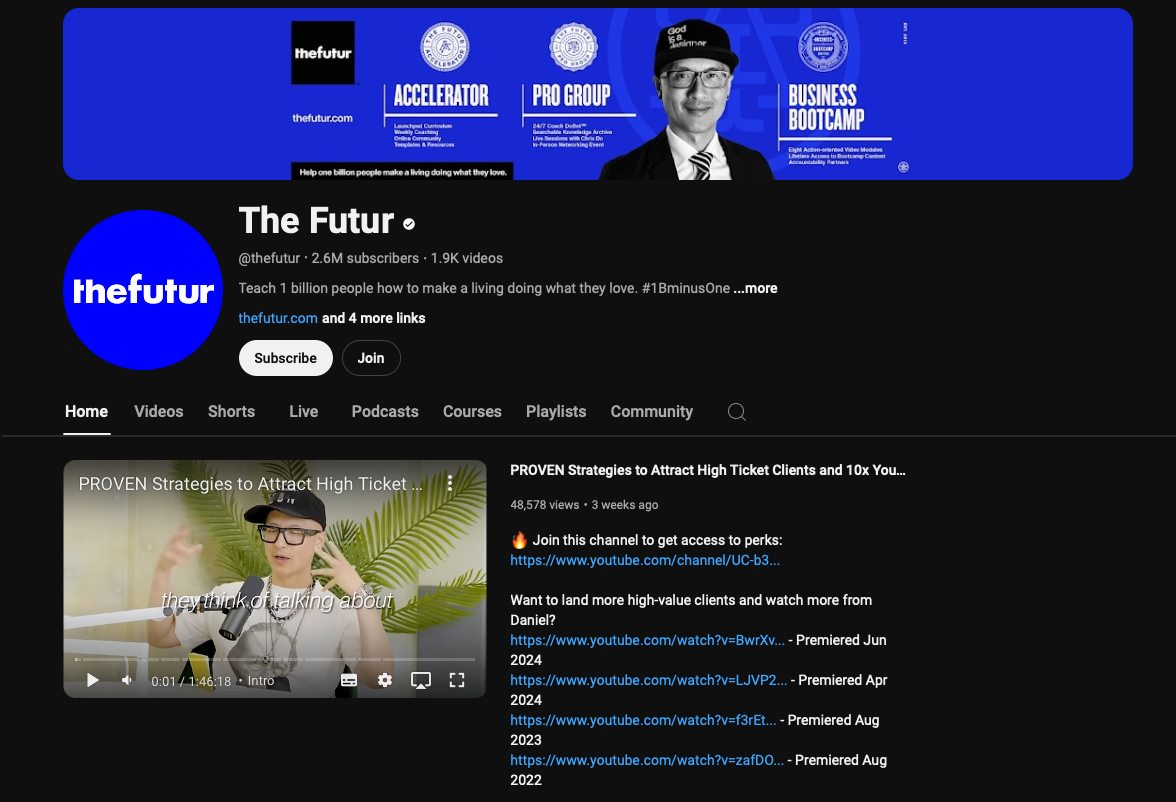
Chris Do is a designer, educator, and business coach who runs The Futur, a platform offering courses, workshops, and resources in design, branding, and business skills tailored to creative professionals.
He has 2.6 million subscribers on YouTube and many more across other social channels.
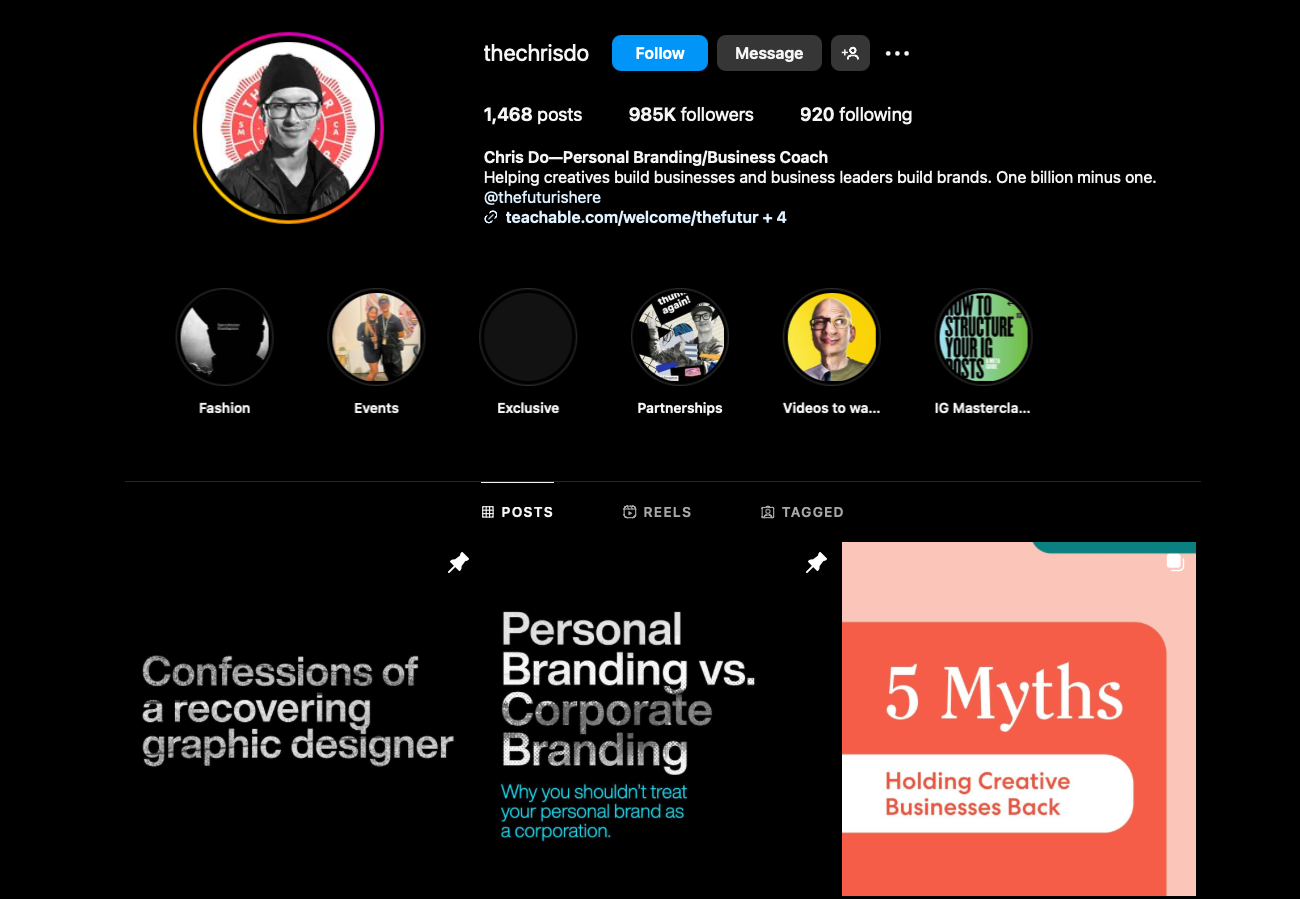
What makes Chris’ brand stand out
Chris' brand is all about helping creatives learn the ins and outs of business. The goal is to help creative people feel empowered and not be scared of taking a few steps outside of their business-related comfort zones.
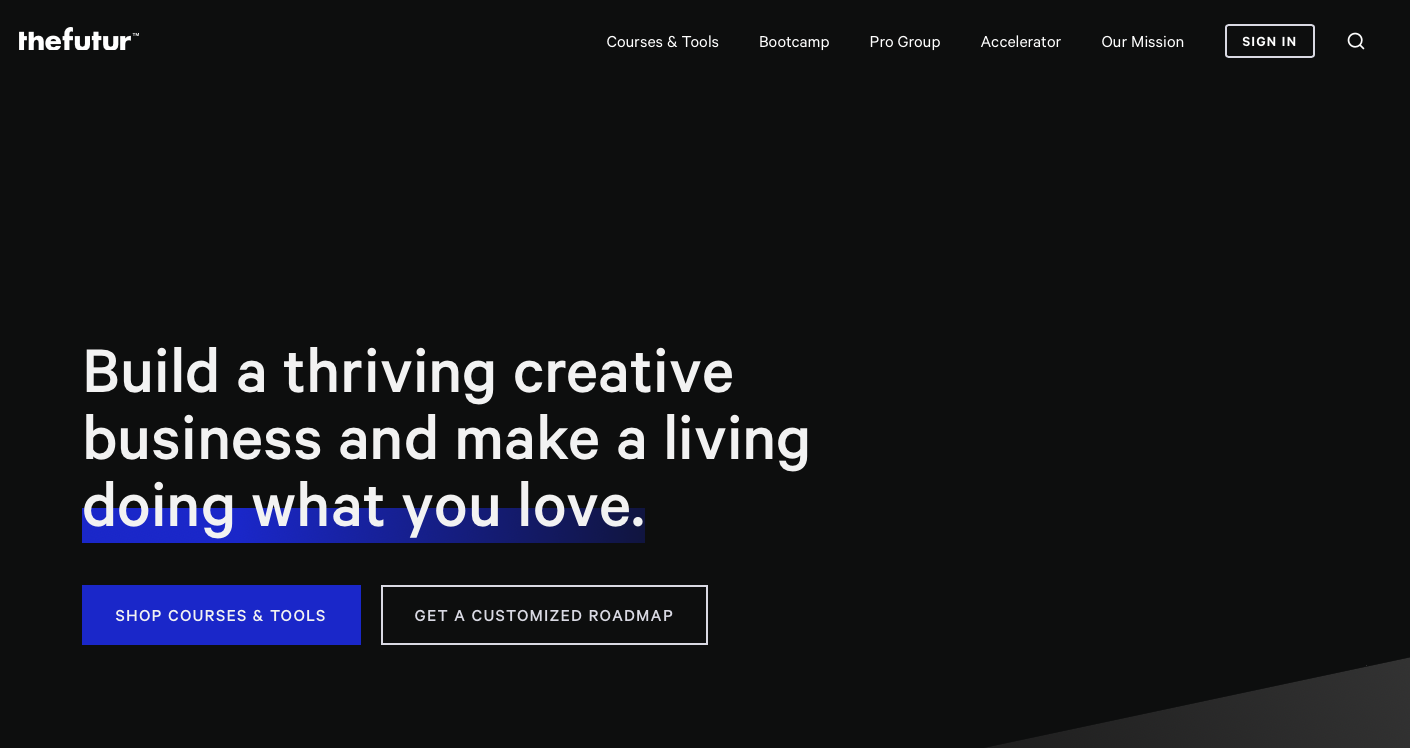
Examples of personal branding used by Chris
In terms of colors, it's all black, be it on his socials or his website. This creates a super sleek look.
Chris works with graphic designers even where it’s not strictly "necessary," showing that he’s willing to go the extra mile to make the company’s image and reputation as strong as possible.
20. Brian Wallack
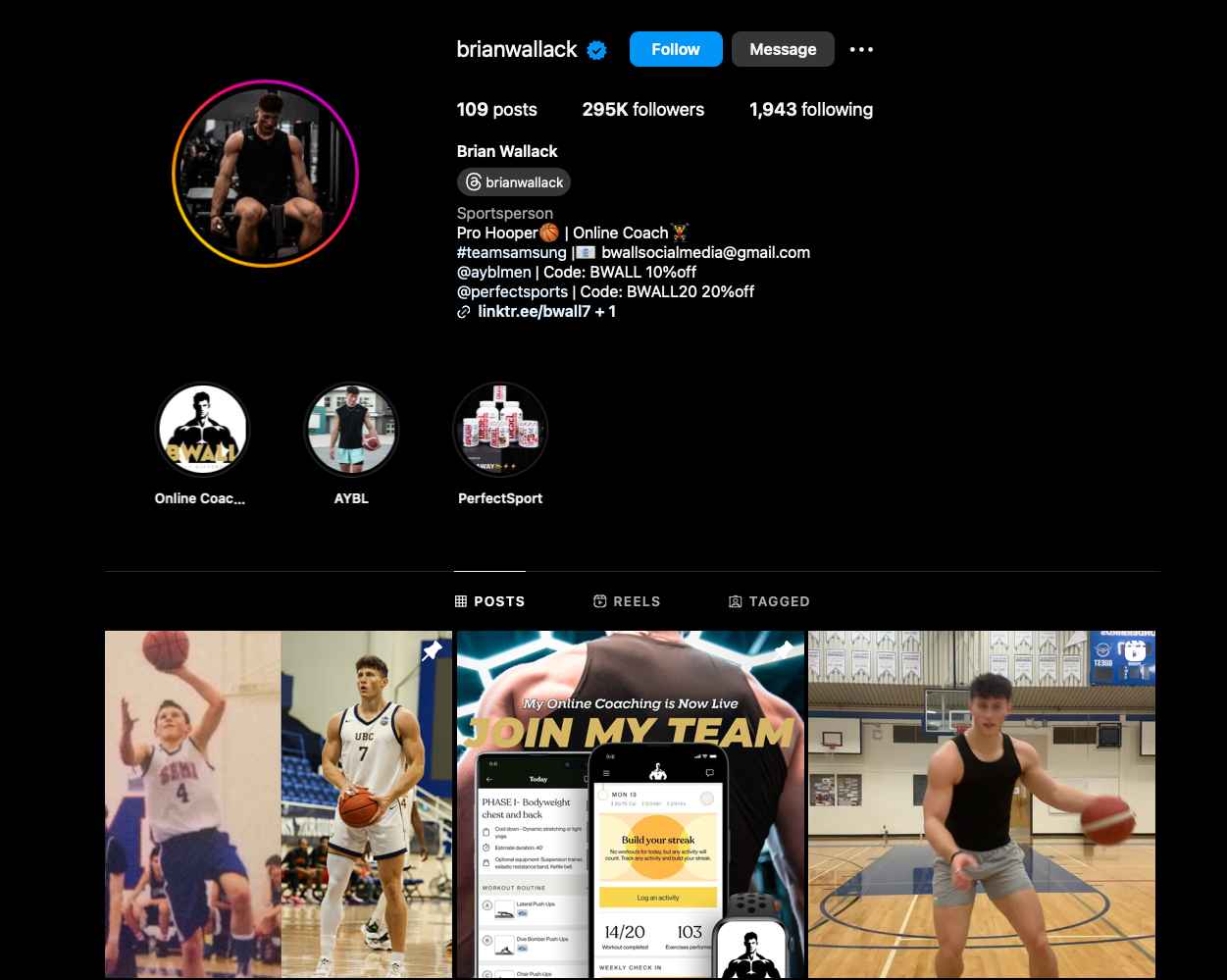
Brian Wallack is a fitness coach and content creator who offers personalized workout and nutrition plans through his platform, BWALL Workouts. He has almost 300,000 followers on Instagram and also runs a coaching community through Whop.
He specializes in helping clients build athleticism, strength, and physique, drawing on his experience as a former college/pro basketball player and his master's in kinesiology.
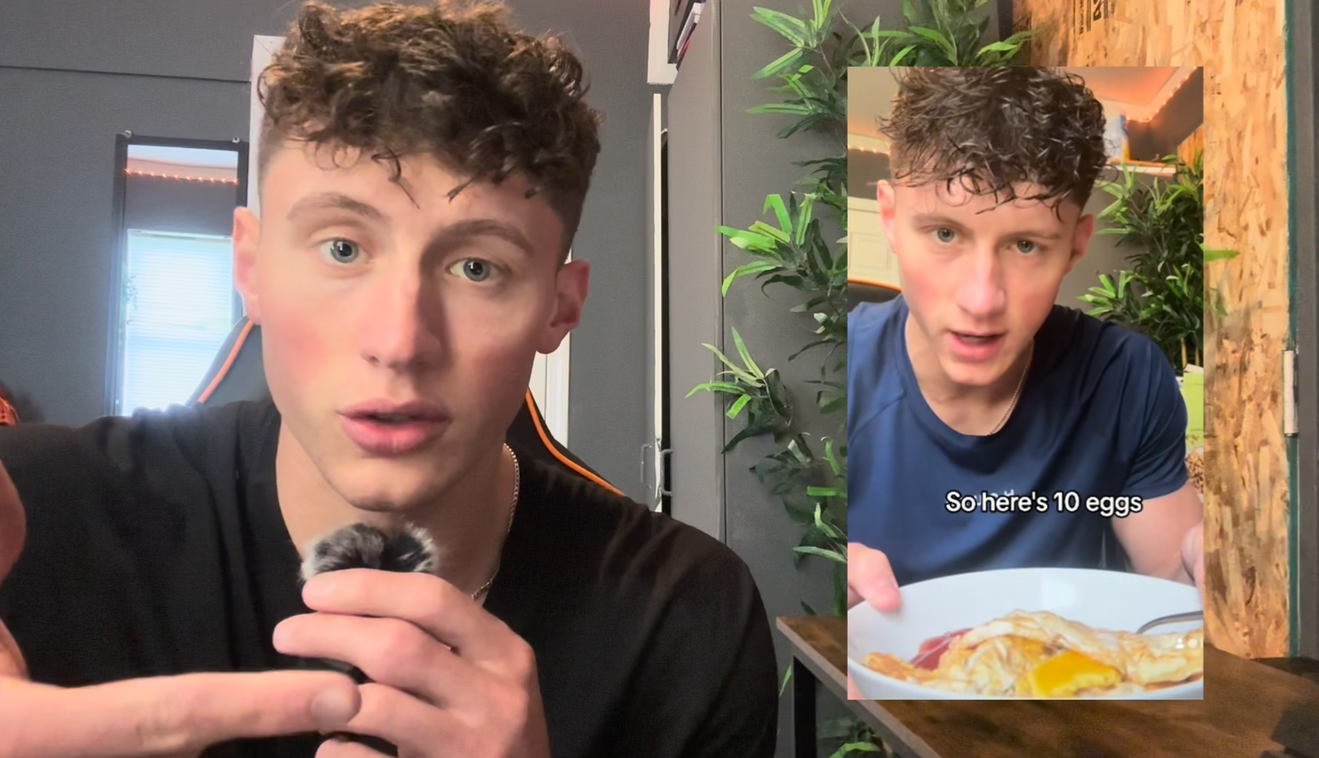
What makes Brian’s brand stand out
Wallack’s brand is built around high-level athletic training principles, applied to everyday fitness enthusiasts.
His expertise in sports science and kinesiology gives him heaps of credibility, while his approachable coaching style makes him a great fit for both casual fitness lovers and more serious athletes.

Examples of personal branding used by Brian
Brian has created a story around his own fitness journey, often showing before and after pictures of what he used to look like.
Fitness coaching is all about inspiring motivation in your clients because, unlike other things, nearly everyone has what it takes to get fit if they just keep at it. Brian makes this the core of his branding by constantly pushing his followers and clients.
How to build your own successful personal brand identity in 14 steps
When personal branding is done well, it all feels very natural. It meshes with the creator’s personality and just looks like the inevitable outcome of that person building a business their own way.
But the reality is quite different.
Even with small one-person businesses, strategy is still strategy, and everything from the language and the photography to the logos and the social media content has been carefully planned and chosen.
The creators in the list I've shown you above are a good mix of self-made and professionally produced. This shows both how the pros do things and how you can get similar results without actually hiring any pros.
At Whop, we meet personal branding experts every day. We work directly with content creators and talk to them to find out what works and what doesn't.
Based on their (and our) expertise, here's a list of 14 steps to help you emulate their amazing personal branding.
1. Decide on a niche
Your drive when you’re starting a project like this might be pretty broad like "I want to create content" or "I want to become an entrepreneur." As motivation, these desires are spot on; as business plans, they’re a little vague.
The first thing you need to do is find a niche. That means deciding what kind of content you want to make or what kind of business you want to run.
You can go in a practical direction like Jasmine Green and her Amazon reselling or Julian Goldie and his SEO, or you can focus on your own passions and interests. This might result in content more like Emma Chamberlain’s with her modeling and coffee business.
Always remember to test your ideas by researching potential competitors and finding out if there’s an audience.
Need some ideas? Check out these:
- Best niches for affiliate marketing
- Lucrative coaching niches
- Ecommerce niches for selling online
- Examples of businesses that found success by niching down
2. Pick your primary platform
As you can see from that list of creators, presence across multiple platforms is pretty important. However, you might also notice that most creators don’t have the same number of followers across all of their socials, and that's totally okay.
This is because people tend to have one primary platform where they start out and focus the majority of their content. As they become more successful, they expand to other socials to increase their presence.
It’s too much for anyone to try and grow five different channels on five different platforms all at once. Copy the pros and pick one hub for all your content that you can then branch out from.
Starting with a whop is a good idea. With your own whop, you can add apps and products to match your services whenever you're ready.
This helps you create a cohesive platform for all your clients and followers to go to whenever they want to connect with you or buy any of your products.
3. Solopreneur, company, or influencer? Take your pick
Next, you can start thinking about your business model. There are three main types you can choose from here.
Being a solopreneur means building a brand around your personal expertise, skills, and experience. This often takes the form of consulting work, online courses, and hosting events.
Running your own company equals focusing less on you as a person and more on building a product that can grow beyond one person. Companies will usually end up with employees, rather than staying a one-man show.
Living the influencer life is all about creating relatable content, personal updates, and collabs with other creators and brands. Many successful influencers grow into solopreneurs or even build their own companies later in their careers.
You can start anywhere you want to—though it’s worth noting that starting a company usually requires more investment. Becoming an influencer or a content creator is open to pretty much anyone, on the other hand, even if you’re under 18.
Picking one model and sticking to it isn’t the most important thing, you can change as your business grows or mix in elements from other models as you want. But to start with, this distinction will really help you focus your branding.
4. Analyze the current status of your personal brand
If your business or brand already exists and you want to improve it, the first step is to analyze what you already have. This means looking over your socials, bios, portfolios, websites, and anything else you’ve created as part of your brand.
Try to make them more unified by working on some new taglines or language patterns that can apply across the board.
Asking friends and colleagues is a great technique here, although it’s important to let them share their raw thoughts rather than just asking them leading questions that will encourage them to say only what you want to hear.
5. Work on your hook
Your hook is the first thing people see when they visit one of your profiles or your website. The idea is to both make it clear what you offer and make the reader want to know more.
Influencers often go whacky with their hooks, while solopreneurs focus on their products. For example, Influencer Sopha Dopha starts her vlogs with 'Heyyyyy girlies!'
Try to create a unique value proposition that identifies what makes you different. For another example, Jasmine Green went with “21-year-old female hustler” because her age and her identity are a big part of her brand.
6. Create a hub for all your work
If you have or plan to have accounts across all the big social media platforms, it’s a good idea to have a hub where you can showcase your work and link out to your official socials.
This both looks professional and makes it easier for people to find all of your channels without risking any unrelated results or fan accounts getting in the way.
The first and easiest step to do this is, again, creating your own whop. Not only can that be used as a hub for all your links, including your socials and your website, but it also becomes a one-stop shop for all your products and services.
Simply put, as soon as someone finds your whop, they get access to everything you offer, from ebooks to a private Discord server to online courses.
Building your own website is another alternative. You can choose whatever platform you like to create your website and use the space to explain who you are and what you do and showcase your products, services, or content (or all three).
7. Share personal examples
Many of Whop's top creators found success for themselves and have now pivoted into sharing their methods with others.
A crucial element of this kind of business model is sharing true and genuine personal experiences.
When a tech mogul says they started out just like you, chances are they’re lying. I'm talking about the CEO of a massive company that's worth billions. Those people rarely start from where we do—they often have generational wealth to help them when they're starting out.
When a solopreneur or an influencer says they started out like you, on the other hand, it’s way more likely to be true! They didn’t use money to become successful, they used the internet, and that’s something most of us actually have access to.
So make the most of this and share your personal experiences with your audience. It builds your brand, it builds trust, it builds credibility, and it allows your viewers to feel closer to you as a person.
8. Work out the visuals
With the right guidance, nearly every aspect of your personal brand can be engineered by you personally. Visuals, however, are the one aspect it’s best to invest in!
Unless you happen to be a photographer and graphic artist yourself, you’ll get much better results if you hire a freelancer or a graphics agency to help you with your logos, colors, and fonts.
Remember that cohesion and consistency are the main goals here—you want people to know a site or a product is yours just from the way it looks.
9. Put a face to the name
Another important part of the visuals is photos. Whether your business is centered around you or not, it’s always good to have a nice professional headshot you can use across your channels.
It helps create a professional look and allows people to connect with you as a person. I recommend going pro here too since properly taken photos look so much better, and it’s also a good way to differentiate your headshot from your normal content if you do appear in videos and photos a lot already.
10. Speak up on social media
Social media is also an essential part of running an online (or at least partly online) business, and that's regardless of whether you choose the influencer business model or not.
Posting content won’t be part of everyone’s main product but it always helps to be present online and engage with others.
If you want someone to choose your company over a different one, you need to give them as many compelling reasons to do so as possible. Sharing some personal updates, showing what kind of life you lead and what kind of person you are is a big part of this.
Not everyone will be interested, but a lot of people will be, and the more open and easy to interact with you are, the happier those people will be. Although life updates might seem unrelated to your core product, you can tie them in pretty easily.
Let's talk examples.
If you’re an entrepreneur who teaches people how to make money, showing off the results of your success helps motivate your customers and gives you a sweet boost to your credibility. That's huge.

If you’re a fitness influencer, you can share glimpses into your daily routine, your family, and your favorite recipes. All those elements contribute to a healthy lifestyle, and they make your followers likelier to trust you if you're consistent across the board.
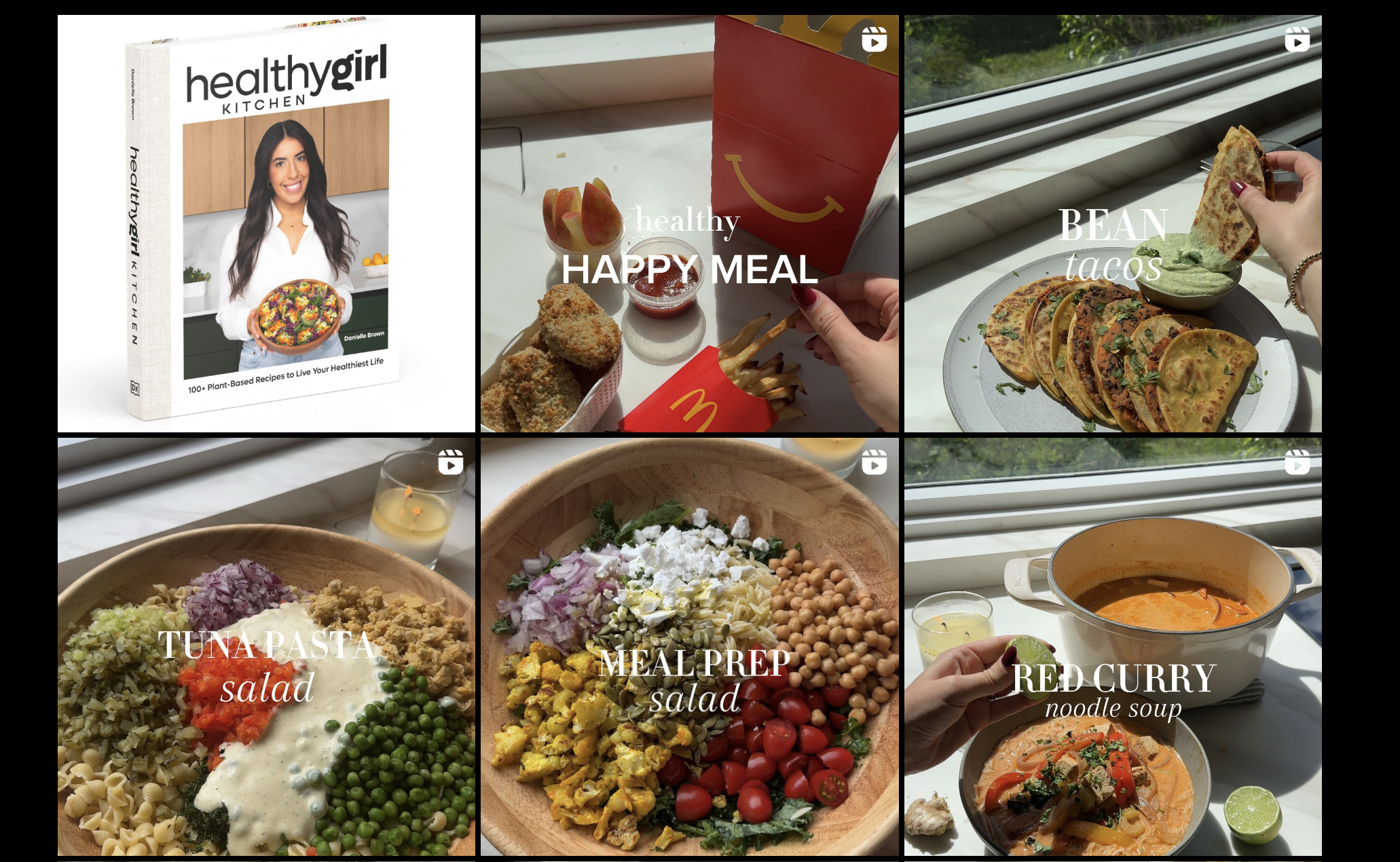
11. Share your story
Create an “About me” video or post to share your story. I mean stuff like who you are, where you’re from, and how you got to where you are today.
It’s a quick and easy way to give people more information when they’re looking for it and to get them interested in your content or product.
Your story is the heart of your personal brand. People are drawn to real experiences, challenges, and triumphs, so let them in on yours!
Talk about why you started, the values that guide you, and the moments that made you who you are.
Not only does this help build trust, but it also sets you apart. No one else has your unique story, so use it to your advantage and let your personality shine through every post, caption, and interaction.
12. Build your brand voice
Your brand voice is how you "sound" in the digital world. Whether you’re witty, inspirational, casual, or professional, your voice should reflect who you are and resonate with your audience.
Keep it consistent across all your platforms, so people feel they’re always talking to the same person. Try to stay conversational and relatable. Speak to your followers like friends rather than just an audience.
And don’t be afraid to play around with different tones until you find one that feels authentic. Your voice should feel like you, but also like someone your followers look forward to hearing from.
13. Keep in touch with your followers
Building a personal brand isn’t just about sharing—it’s about engaging. Take time to respond to comments, answer questions, and interact with your followers.
Ask them questions, respond to their stories, and acknowledge their support to make them feel engaged and involved.
Try using polls, Q&A sessions, or going live to interact in real time. This back-and-forth not only builds loyalty but also turns followers into a true community around your brand.
You can even go the extra mile and use the Video Calls app on Whop to offer your followers personalized, one-on-one calls with you.
14. Stay true to yourself (and evolve)
Authenticity is everything. While it can be tempting to follow trends, remember that staying true to yourself is what makes you unique.
That doesn’t mean you can’t change, of course not. Your brand should grow just as you do!
But let your evolution happen naturally and be transparent about it. Let your followers in on your journey, your new ideas, and your changing perspectives. Ask them what they think and what they want to see from you.
You can even use polls to find out how much of your community is interested in a potential new digital product or project. This is a great way to minimize risk for you and maximize satisfaction for them.
Build the perfect hub for your personal brand with Whop
As I compiled this list of some of the best examples of personal branding, I couldn't help but notice how broad a category this is. Out of 20 creators, they each had their own niche and their own unique set of skills.
And yet, there was one thing all of these businesses and entrepreneurs had in common: They went the extra mile to connect with their followers.
Their brands are highly personal, speaking directly to their followers at every turn.
There's a reason for that: A community-based, personal approach is what makes your brand memorable, and that leads to success.
But how do you achieve that? Where do you start? Don't worry—I know exactly what you need to do.
The best way to build your own brand and connect with your followers is through Whop. A whop is an online hub where you can sell all sorts of digital products like:
- Ebooks
- Videos
- Apps
- Online courses
- Exclusive communities
- Subscriptions
- Downloadables
- Video calls
- …and so much more
But your whop isn't just a place that can make you money (although some of our top creators break $250K every single month).
A whop is an outstanding space for you and your audience. It lets you connect with them on a whole new level.
By adding apps you can bring all the features you need to your hub, from chat rooms and customer support to video calls and online courses. You can create different pricing tiers and memberships as well as sell one-off payment products and services.
There's no better way to build or nurture your brand than to use that personal touch that's worked so well for every single creator on this list.
FAQs
What are some examples of personal branding?
Examples of personal branding include your company or brand logo, the color themes you use across your products and socials, and the language you use. These things determine how your brand looks to other people and make a huge difference in building trust and loyalty.
What is meant by personal branding?
Personal branding is how you market yourself and your products. Someone with no personal branding would have no logo, no cohesion between their products, and would interact with their customers in completely different ways from one day to the next.
Personal branding is simply making some rules and decisions to decide on how you want to present yourself, as well as hiring some designers to make you a logo and a color scheme!
What are the 7 pillars of personal branding?
According to Forbes, the seven pillars of personal branding are: Purpose, values, brand clarity, authenticity, strengths, energy, and legacy. They highlight just how important it is to create a cohesive brand that's easy to trust in.
